Paying the bills
How to get £1,500 post-tax monthly income in retirement


VOL 25 / ISSUE 05 / 09 FEBRUARY 2023 / £4.49
FEATURE The most popular stocks and funds for people drawing on their pension


• Red-hot US jobs figures cause confusion over market direction

• How bad was Apple’s latest update and has the investment case changed?
• Investors jump back on Tesla bandwagon as shares soar 80% in weeks
• Auction Technology loses its shine as a rapid growth story


New: Vanguard Global Equity Fund / Hilton Food


09 February 2023 | SHARES | 03 Contents 06 NEWS
GREAT IDEAS
13
Updates:
18 FEATURE Paying the bills:
to
monthly
24 FEATURE The 80s and 90s market stars which could have made you a million 28 FEATURE Revealed: The most popular stocks and funds for people drawing on their pension 31 EDITOR’S VIEW BT and Vodafone are both struggling to dial up growth – here’s why 32 FEATURE Shine as an investor: Six golden rules to help you on the path to success 35 CASE STUDY Taking the plunge and making money from the markets full-time 38 EDUCATION How compounding works in investing and why it is important 40 PERSONAL FINANCE Eight big tips to beat the taxman this April 44 RUSS MOULD Markets must keep watching Japan as there are big risks brewing 46 ASK TOM How do I complain about an employer shutting me out of a workplace pension scheme? 47 INDEX Shares, funds, ETFs and investment trusts in this issue 28 44 18 13 06
GSK
How
get £1,500 post-tax
income in retirement
Red-hotUSjobsfigurescause confusionovermarketdirection
towelInvestorsareloathedtothrowinthe afterthelatestrallyL astweek’smuchstronger-than-expected Januaryemploymentreportfromthe BureauofLabourStatisticshasthrown investorsacurveballwhenitcomesto forreadingtheUSeconomyandthereforetheoutlook Theinterestratesandthestockmarket. employmentnon-farmlaboursurveyshowedUSincreasedby517,000jobslastmonth, timesalmosttwiceDecember’sfigureandnearlythree theforecastof185,000jobs. Atthesametime,growthinaveragehourly wellearningsslowedfrom4.9%inDecemberto4.4%, addingbelowtheforecastofanother4.9%print, totheconfusion. Theinitialreactionfrominvestorswastosell stocksasarampantjobsmarketistopofthe FederalReserve’s‘hitlist’whenconsideringfuture interestraterises.
Yetaconsensusquicklyemergedthatastrong jobsmarketwasprooftheFedcancontinueraisingrateswithoutcausinga‘hardlanding’forthe economy.
Stocks have been soaring this year on investor optimism but there continue to be plenty of negative signals in the market
Thisbehaviouristypicalofthelastcouple ofmonths,whereriskappetitehasclearly outweighedcautiontotheextentthatstockswhich havemissedearningsforecastshaveoutperformed thosewhichhavemetorbeatenexpectations. latestAsanalystsatBankofAmericapointout,the reports’rallywaskick-startedby‘theugliestofCPI lastOctoberandwillprobablyendwitha ‘peakGoldilocks’inflationreportwhichconvinces investorstheall-clearhassounded,allowingthe Fedtopivotfromraisingtocuttingrates. Thereareobvioussignsofexcesseverywhere inmarkets,frombonds–wherethespreadof sub-investmentgradeyieldsoverUSTreasuriesis thelowestsince1981–toequities,suchasTesla (TSLA:NASDAQ)whosesharepricehasrisen80% upyear-to-date,tocryptocurrencieswherebitcoinis Further39%sofarthisyear.evidencecomesfromtheCNNFearand ofGreedindex,whichhasswungfroma‘neutral’level greed’47/100amonthagotoareadingof‘extreme at76/100asoftheendoflastweek. Drivingtheextremegreedsentimentreadingare manymoreUSstocksmakingnewhighsthannew lows,asignificantexcessofstocksrisingoverthose sellfalling,alowlevelofbuyingof‘puts’(optionsto theindex)comparedwith‘calls’(optionstobuy overtheindex)andstrongexcessreturnsfromstocks bondsoverthepastmonth. Atthisstagewewouldmaketwoobservations: employmentisalaggingindicator,sotheJanuary non-farmreportmaybeananomaly;and monetarypolicyworkswithalag,whichmeans wehavebarelybeguntoseethetrueeffectonthe economyoftheFedraisingratesfrom0.25%to 4.75%injust12months.[IC]

Investors need to get their head round why equities are doing well and what could spoil the party


Feature:Drawingonyourpension
andRevealed:themostpopularstocks theirfundsforpeopledrawingon

Three important things in this week’s magazine 2 3

andThereareafewinterestingadditions income-payingomissionsbeyondclassicstocksandfunds Ihavenvestorsdrawingdowntheirpensiononly selectedexposuretogrowthstocks andingeneraltheyarestickingtoincomegeneratingsharesandfunds.ThisisaccordingtoanalysisofAJBell’scustomerholdingsbyShares keepingManypeoplearelivingforlongerandare theirpensioninvestedinthemarketin thehopeofachievingcapitalgrowthaswellas thisincome.BasedonAJBell’scustomerbehaviour doesn’textendtoputtingmoneyintooverseaslistedstockssuchasTesla(TSLA:NASDAQ)and Apple(AAPL:NASDAQ)whicharefarmorepopular theiramonginvestorswhoarestillbuildingupwealthin preferredInstead,pension.FTSE100companiesareamongthe waystomaintainexposuretothemarketbyforpeopleindrawdown.Thiscanbeexplained payers,theindexfeaturingmanygenerousdividend asevidencedbythelikesofLloyds(LLOY) Shell(SHEL)andBP(BP.)beingamongthetop theirholdingsforAJBellcustomersalreadydippinginto pensionpot.
EXPOSURETORISKIERINVESTMENTS ofWhatmightcomeasasurpriseisthepopularity ScottishMortgageInvestmentTrust(SMT) payamongpeopletakingmoneyfromtheirpensionto (self-investedthebills.It’sthetopholdingforAJBellSIPPs personalpensions)bynumberof theircustomers,acrossboththosetakingmoneyoutof potandthosewhoarenotyetindrawdown.exposedItmeansalotofpeopleinretirementaretoaninvestmentvehiclethathashigher theriskholdings.ScottishMortgageaimstoinvestin holdbigcompaniesoftomorrowandisn’tafraidto stocksthattradeonhighvaluations.Italsohaslargeexposuretoprivately-ownedbusinesses. FundsmithEquityFund(B41YBW7)isalsoa
Many investors dipping into their pension are happy to hold higher risk investments
Scottish Mortgage Investment Trust is the most popular holding for AJ Bell SIPP customers in drawdown


Visit our website for more articles
Did you know that we publish daily news stories on our website as bonus content? These articles do not appear in the magazine so make sure you keep abreast of market activities by visiting our website on a regular basis.
Over the past week we’ve written a variety of news stories online that do not appear in this magazine, including:
Draw up a plan if you want to have enough money for a comfortable retirement
This week’s main feature looks at how someone can get a £1,500 post-tax monthly income from pensions
to its all-time highs
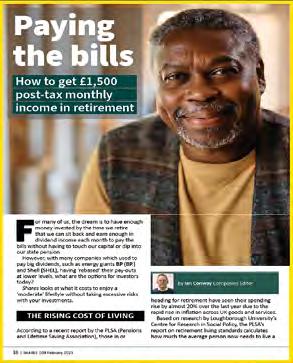
04 | SHARES | 09 February 2023 Contents 1 News 06 SHARES 09February2023
Stock Markets so far in 2023 Nasdaq 13.6% CAC 40 10.3% DAX 10.2% FTSE 250 7.9% HangSeng 7.7% S&P 500 7.1% Nikkei225 6.1% FTSE 100 5.6% CSI 300 5.6% Table:Sharesmagazine Source:SharePad,7Feb2023
28 | SHARES 09February2023
pension AJMostpopularstocksandfundsfor Bell SIPP customers in drawdown Scottish LloydsMortgage GSK Shell Haleon FundsmithEquity LegalFund & BPGeneral Vodafone Aviva National UnileverGrid RioTinto AstraZeneca CityofLondonInvestmentTrust Table:Sharesmagazine Source:AJBell
The FTSE 100 companies riding under the radar contributing
BP shares gain after record annual profit, dividend hike and share buyback
Ford full-year earnings miss estimates after profit ‘left on the table’
Brewer Carlsberg warns higher prices to hurt beer sales this year
To be ahead in Asia, be on the ground.
abrdn Asian Investment Trusts
In Asia, life and business move fast. To invest here successfully, you need local knowledge. abrdn has had investment teams in Asia for almost 40 years. So we get to know markets, companies, trends and innovations first hand. And you get to select from investment trusts featuring the most compelling Asia opportunities we can find.

To harness the full potential of Asia, explore our Asian investment trusts on our website. Please remember, the value of shares and the income from them can go down as well as up and you may get back less than the amount invested. Asian funds invest in emerging markets which may carry more risk than developed markets.
Request a brochure: 0808 500 4000 invtrusts.co.uk/asia
Issued by abrdn Investments Limited, registered in Scotland (SC108419) at 10 Queen’s Terrace, Aberdeen, AB10 1XL, authorised and regulated in the UK by the Financial Conduct Authority. Please quote 2999.
Red-hot US jobs figures cause confusion over market direction

Investors are loath to throw in the towel after the latest rally
Last week’s much stronger-than-expected January employment report from the Bureau of Labour Statistics has thrown investors a curve ball when it comes to reading the US economy and therefore the outlook for interest rates and the stock market.
The non-farm labour survey showed US employment increased by 517,000 jobs last month, almost twice December’s figure and nearly three times the forecast of 185,000 jobs.
At the same time, growth in average hourly earnings slowed from 4.9% in December to 4.4%, well below the forecast of another 4.9% print, adding to the confusion.
The initial reaction from investors was to sell stocks as a rampant jobs market is top of the Federal Reserve’s ‘hit list’ when considering future interest rate rises.
Stock Markets so far in 2023
This behaviour is typical of the last couple of months, where risk appetite has clearly outweighed caution to the extent that stocks which have missed earnings forecasts have outperformed those which have met or beaten expectations.
As analysts at Bank of America point out, the latest rally was kick-started by ‘the ugliest of CPI reports’ last October and will probably end with a ‘peak Goldilocks’ inflation report which convinces investors the all-clear has sounded, allowing the Fed to pivot from raising to cutting rates.
There are obvious signs of excess everywhere in markets, from bonds – where the spread of sub-investment grade yields over US Treasuries is the lowest since 1981 – to equities, such as Tesla (TSLA:NASDAQ) whose share price has risen 80% year-to-date, to cryptocurrencies where bitcoin is up 39% so far this year.
Further evidence comes from the CNN Fear and Greed index, which has swung from a ‘neutral’ level of 47/100 a month ago to a reading of ‘extreme greed’ at 76/100 as of the end of last week.
Driving the extreme greed sentiment reading are many more US stocks making new highs than new lows, a significant excess of stocks rising over those falling, a low level of buying of ‘puts’ (options to sell the index) compared with ‘calls’ (options to buy the index) and strong excess returns from stocks over bonds over the past month.
Yet a consensus quickly emerged that a strong jobs market was proof the Fed can continue raising rates without causing a ‘hard landing’ for the economy.
At this stage we would make two observations: employment is a lagging indicator, so the January non-farm report may be an anomaly; and monetary policy works with a lag, which means we have barely begun to see the true effect on the economy of the Fed raising rates from 0.25% to 4.75% in just 12 months. [IC]
News 06 | SHARES | 09 February 2023
Nasdaq13.6% CAC4010.3% DAX10.2% FTSE2507.9% HangSeng7.7% S&P5007.1% Nikkei2256.1% FTSE1005.6% CSI3005.6% Table: Shares magazine • Source: SharePad, 7 Feb 2023
How bad was Apple’s latest update and has the investment case changed?
There were several bits of encouraging news in its results despite missing earnings forecasts
iPhone maker Apple (AAPL:NASDAQ) reported a rare double miss for its first quarter earnings, running to 31 December 2022. Both revenue and earnings fell short of consensus estimates following a sales decline in nearly every product category. While disappointing, Shares doesn’t believe the investment case has changed, with Apple remaining a must-have stock for investment portfolios.
Earnings per share of $1.88 on sales of $117.2 billion represented a three to four percentage point miss, which might not seem much on the revenue line, but that’s more than $4.5 billion of income. This was the first time since October 2021 that Apple had fallen short on sales, and it was the worst revenue performance since the September 2016 quarter.
Revenue declined for its iPhone (-8%), Mac computers (-29%), and wearables including watches and earphones (-8%). However, iPad sales grew about 30% and services were up by

6%, partially offsetting losses. The decline in iPhone revenue was due to supply shortages, macroeconomic pressures, currency headwinds, and arguably poorer sales for the iPhone 14 model.
SUPPLY CHAIN TROUBLES NOT NEW
Apple struggling to manage production difficulties for the iPhone and its other family of tech gadgets is not new news, nor has it been exclusive to the company. Almost all tech-related companies with operations in China have suffered to some degree during the past year given the country’s stubborn Covid lockdown restrictions.
While earnings and sales disappointed, there were enough positives to keep many investors
How Apple and big tech peers performed in latest quarterly earnings results
News 09 February 2023 | SHARES | 07
Apple 1.88/1.94(MISS)117.2/121.88(MISS) Alphabet 1.05/1.18(MISS)76.05/76.07(MISS) Amazon 0.03/0.17(MISS)149.2/145.64(BEAT) Microsoft 2.32/2.30(BEAT)52.7/53.12(MISS) Meta Platforms 1.76/2.26(MISS)32.17/31.53(BEAT) Tesla 1.19/1.15(BEAT)24.32/24.68(MISS) Netflix 0.12/0.59(MISS)7.85/7.84(BEAT) Actual earnings vs forecast $ Actual revenues vs forecast $bn Table: Shares magazine • Source: Company updates, Investing.com
Change in guidance for next 12 months following latest quarterly update
and devices and then collects a regular stream of subscription payments afterwards as people are plugged into its ecosystem, paying for things like music and film streaming and fitness activities.
This is potentially higher margin software and intellectual property-based revenue. It requires no parts and components to buy and ship to manufacturing bases, the back again to stores, which encourages optimism that operating and net margins that touched 29.4% and 24.6% respectively in the last quarter are sustainable and could go higher still.
SHARE PRICE UP AFTER THE NEWS
optimistic. First, Apple has called the end to the production and supply chain issues that dogged much of 2022. Second, Apple has a potentially large tailwind for earnings in the coming months as China accelerates its reopening and people start to get out and spend more.
During the earnings call, chief executive Tim Cook was asked whether the increase in average sales prices for iPhones was sustainable, to which he replied, ‘I think people are willing to really stretch to get the best they can afford in that category,’ adding that iPhones had become ‘integral’ to people’s lives.

Cook didn’t specifically say whether prices will continue to rise, but that comment certainly suggests that he thinks customers could be persuaded to pay ever more for the company’s prized smartphones.
It’s a surprisingly confident statement, especially in the current financial climate. Even in a healthier economy, the idea of people needing to ‘really stretch’ their budget to afford a premium smartphone might sound dubious, but Cook has proved right in the past. It will be interesting to see how this plays out.
Third, Apple’s services business hit an all-time revenue record of $20.8 billion during the quarter. The company makes money from selling handsets
This goes some way to explaining why the market’s immediate reaction to the update was to push the stock 2.4% higher to $154.50, levels not seen since October last year and continuing the growth and tech stock recovery seen so far in 2023.
Even having eased back slightly to $151.90, it still means Apple shares have rallied close on 15% since Shares encouraged readers in December to buy the stock as one of our key selections for 2023.
While Apple is just as conscious of keeping its running costs in check as any big tech peer, it has so far resisted any temptation to make widespread redundancies. Letting people go is a ‘last resort,’ Cook told the Wall Street Journal, but it is a useful chess piece to bring into play if a recession does land on a global scale, and consumer belts tighten further.
Dan Ives, analyst at US broker Wedbush, believes Apple remains in a unique situation to withstand this economic storm better than its tech peers.
Apple no longer provides the exact number of iPhone units sold but Ives estimates that eight to 10 million iPhone sales were shifted out of the holiday season because of supply chain shortages. The company expects the March quarter year-onyear revenue performance to accelerate relative to the December quarter.
The macro backcloth remains uncertain, but the iPhone maker has proved resilient in past economic squeezes, and we continue to see the shares as a sound investment for 2023 and beyond. [SF]
News 08 | SHARES | 09 February 2023
Apple −1.5%−0.6%−1.9% Alphabet −3.2%−4.4%−0.6% Amazon −0.4%−13.1%7.8% Microsoft −1.8%−2.1%−2.0% Meta Platforms 1.3%10.4%40.6% Tesla −2.0%−8.2%−3.7% Netflix 0.9%5.4%24.7% Revenue Earnings per share Free cash flow
Table: Shares magazine • Source: Consensus Gurus
Investors jump back on Tesla bandwagon as shares soar 80% in weeks
Electric car maker is back in fashion as investors return to growth stocks
If an example of how fast market moods can change were needed, you’ll find few better than the 2023 version of Tesla (TSLA:NASDAQ). A stock market pariah right through 2022, shares in the electric cars-to-energy firm are up about 80% in the handful of weeks this year, adding $250 billion to its market value.
Optimism from analysts has certainly helped fuel the stock’s rally, the latest from Berenberg,

after the investment bank put Tesla on its buy list despite lowering its target share price to $200.

Investors seem willing to buy into the idea that price cuts across a number of models are not necessarily a bad thing, if they can successfully lure Chinese buyers. The flipside is pressure on industry-leading margins which is yet to be fully reflected in Tesla’s numbers.
Based on surveys, analysts at

Auction Technology loses its shine as a rapid growth story

The shares have been hit hard by multiple downgrades to earnings forecasts
Down more than 50% since the start of 2022, Auction Technology (ATG) has been hit by various factors which have led to multiple downgrades to earnings forecasts in recent months.
The company provides online auction marketplaces to help auctioneers reach a bigger audience than the traditional inperson channel.
Approximately 80% of sales come from the US where it faces foreign exchange headwinds. Earnings
DOWN in the dumps
estimates have also been hit by a decline in asset prices and volumes, and higher investment in the business. Sales growth is forecast to slow considerably in the current financial year.
The stock is still relatively expensive despite the share price decline. According to data from Stockopedia, Auction Technology trades on 20 times EV to EBITDA (enterprise value to earnings before interest, tax, depreciation and amortisation) and 22 times
Wedbush are also telling clients that the China EV reacceleration story for Tesla is just starting to hit its stride and should be a tailwind in the first quarter. [SF]
forward earnings.
Berenberg says there are reasons to be optimistic, including more revenue coming from value-added services and the potential to drive more bidders on its platform via investments in search engine optimisation, text messages and other new marketing features. [DC]
News 09 February 2023 | SHARES | 09
Tesla ($) Aug 2022 SepOct Nov DecJan 2023 Feb 100 150 200 250 300 Chart: Shares magazine • Source: Refinitiv Auction Technology (p) 2022 2023 600 800 1,000 1,200 1,400 1,600 Chart: Shares magazine • Source: Refinitiv
HIGHER Moving
UK UPDATES OVER THE NEXT 7 DAYS
FULL-YEAR RESULTS
14 February: Carr’s, Coca-Cola HBC, Plus500
15 February: Barclays
16 February: Centrica, HarbourVest Global Private Equity, Moneysupermarket, RELX
HALF-YEAR RESULTS
15 February: Dunelm, Hargreaves Lansdown
16 February: MJ Gleeson
TRADING UPDATES
14 February: TUI
16 February: Supermarket Income REIT
Moneysupermarket could be in demand
Consumers are increasingly looking to switch products and economise where they can

Given there has been no sign of a letup in the ongoing cost-of-living crisis, we suspect price comparison website operator Moneysupermarket.com
47% as interest rates continued to rise, and the firm raised its profit guidance to the top end of market expectations. The firm cautioned that conditions in the wholesale energy market and the introduction of the Energy Price Guarantee meant it was unlikely energy switching would make a comeback
Bookings in focus at TUI
Investors will also be looking to see the extent the company has been able to pass on costs
Investors have fallen back in love with holiday companies in 2023 so it is appropriate that package seller TUI (TUI) will report results on Valentine’s Day (14 February) for the 12 months to 30 September 2022. Increased prices and how firm bookings are for the upcoming summer season will be closely watched, especially against a tricky economic backdrop. The stock has rallied 26% so far in 2023. [SF]

10 | SHARES | 09 February 2023
News: Week Ahead
Can Coca-Cola continue to sparkle?


The Atlanta-based drinks giant has brand strength and pricing power
Fourth quarter and full year earnings (14 February 2023) from Coca-Cola (KO:NYSE) should confirm that the drinks giant sustained positive sales momentum in the final three months of 2022, and investors will be eager to see if consumers have continued to swallow price increases from the beverages
behemoth. The $260.7 billion cap, whose brands span iconic soft drink Coke and the likes of Sprite, Fanta, Schweppes and Costa, upgraded guidance for 2022 following a sparkling third quarter in which price increases helped organic sales fizz 16% higher. Much hinges on the guidance Coca-Cola gives for 2023 and there will be interest around what chairman and CEO James Quincey has to say about commodity costs and the recent reopening of China. [JC]
US UPDATES OVER THE NEXT 7 DAYS
QUARTERLY RESULTS
Market more optimistic on Airbnb

Shares in the home rental platform are up 40% year-to-date
Wall Street has been getting more optimistic about growth companies this year and fourth quarter earnings (14 February) from Airbnb (ABNB:NASDAQ) will put that to the test. The third quarter was strong, the company booking 25% higher volumes
while rising prices helped push revenue up 36% after accounting for currency swings. The stock is up 40% year-todate. Consensus forecasts are pitched at $0.25 earnings per share on $1.86 billion revenue for the home and roomrental platform. [SF]
13 February: Arista Networks, Avis, Cadence Design, DBS Group, Palantir Technologies, SolarEdge Technologies
14 February: Airbnb, Coca-Cola, Devon Energy
15 February: AIG, Biogen, Cisco, Kraft Heinz, Shopify
16 February: Applied Materials, Datadog, DoorDash
09 February 2023 | SHARES | 11 News: Week Ahead
While we are resolutely bottom-up and stock-focused in our approach, this does not stop us from looking at the big picture. That’s why every year we publish our research agenda, outlining the key themes we intend to focus our attention on over the year ahead. We see it as a guide to discovering unrecognised growth opportunities and potentially a better way to help deliver returns you can look forward to.
Please remember that changing stock market conditions and currency exchange rates will affect the value of the investment in the fund and any income from it. Investors may not get back the amount invested.
Find out more at monksinvestmenttrust.co.uk A Key Information Document is available.

Your call may be recorded for training or monitoring purposes. Issued and approved by Baillie Gifford & Co Limited, whose registered address is at Calton Square, 1 Greenside Row, Edinburgh, EH1 3AN, United Kingdom. Baillie Gifford & Co Limited is the authorised Alternative Investment Fund Manager and Company Secretary of the Trust. Baillie Gifford & Co Limited is authorised and regulated by the Financial Conduct Authority (FCA). The investment trusts managed by Baillie Gifford & Co Limited are listed UK companies and are not authorised or regulated by the Financial Conduct Authority. Actual Investors THE
MONKS INVESTMENT TRUST
picture.
can make a big
to your portfolio.
The big
Seeing it
difference
Call 0800 917 2112.
Not sure if growth or value will thrive? This Vanguard fund has both
Having a blend of both investment styles looks wise in this unpredictable market
Fundsmith Equity (B41YBW7) charges (0.94%) for its portfolio of stocks from around the world.
Unlike many global equity funds, the Vanguard product is not dominated by big US tech firms. Yes, there are positions in Microsoft (MSFT:NASDAQ) and Alphabet (GOOG:NASDAQ), but they sit alongside names such as US health insurance provider Elevance Health (ELV:NYSE), aerospace group Airbus (AIR:EPA) and miner Rio Tinto (RIO).
VANGUARD GLOBAL EQUITY FUND
Investors are right to be confused by the current direction of the market. The FTSE 100 hitting a record high and many stocks recording double-digit gains this year would suggest everything’s rosy. On the other hand, central banks haven’t finished pushing up interest rates, big companies are slashing jobs and plenty of consumers are still under financial pressure.
In this situation, it’s difficult to know exactly how to position your portfolio – do you go fullon growth again, or be more cautious and have value stocks which are providing jam today rather than jam tomorrow? The answer might be to do both and that’s exactly what you’re getting with Vanguard Global Equity Fund (BZ82ZT6).
While Vanguard is best known in the UK for its passive tracker funds, this global equity fund is actively managed by a panel of experts. Baillie Gifford looks after half the assets, and it has a growth investing style. The rest is managed by Wellington which is a value investor so you’re getting a blend of both styles.
The track record has been good, with the fund in the top quartile for performance over the past one and three years. Since launch in May 2016, the Vanguard fund has returned 140% versus 124% from the MSCI All-Countries World index in sterling, according to FE Fundinfo. The 0.48% ongoing charge is approximately half the amount
Construction group CRH (CRH) has been a key contributor to the portfolio with its share price hitting a new record high earlier this month. Other names picked by the fund include Spanish utility group Iberdrola (IBE:BME), drinks group Pernod Ricard (RI:EPA) and airline Ryanair (RYAAY:NASDAQ).

Investors are likely to get the bulk of their returns as capital gains rather than income as the dividend yield is a mere 1%.
It’s important not to confuse the fund with another Vanguard product of the same name which is marketed to US investors. That has a different manager line-up and a slightly different approach. [DC]
DISCLAIMER: The author owns units in Vanguard Global Equity and Fundsmith Equity referenced in this article.
Global Equity
09 February 2023 | SHARES | 13 Great Ideas: Investments to make today
( p ) 201820202022 10,000 15,000 20,000 Chart: Shares magazine • Source: Refinitiv
Vanguard
(BZ82ZT6) Price: £239.73 Assets: £323 million
Hilton Food is a great business at a great price so invest now
The meat and fish packing company needs to regain the market’s confidence, but the shares are just too cheap at these levels

HILTON FOOD
BUY
(HFG) Price: 674p
Market cap: £606 million
We think recent problems at Hilton Food (HFG) have created an opportunity to buy shares in a previous top market performer and quality business at an attractive price.
The global meat and fish packing business supplies retail titans ranging from Tesco (TSCO) and Ahold Delhaize (AD:VIE) to Australia’s Woolworths (WOW:ASX) under long-term contracts.
Shares in the red meat-to-vegetarian meals supplier started to recover last month after being roiled by two profit warnings last year. Reassuringly, the FTSE 250 food producer avoided having to dish out a third warning in its latest update, instead serving up news of positive progress in the rehabilitation of its UK seafood business.
Hilton trades on an undemanding
12.3 times forecast 2023 earnings and offers a prospective dividend yield of 4.1%.
WHAT DOES HILTON FOOD DO?
Guided by CEO Phillip Heffer, Hilton furnishes its retail partners and food service customers around the world with high-quality meat, seafood, vegan and vegetarian foods and meals. It is well placed to cater to burgeoning global demand for affordable protein products.
The £606 million business runs automated and robotised food processing, packing and logistics facilities for major international retailers across Europe, Asia Pacific and North America and through economies of scale, is able to secure significant efficiency savings for customers while also carving out a nourishing margin for itself.
acquisition of Fairfax Meadow”
Hilton’s core business of packing red meat for retailers in Europe and Australasia remains solid, even though consumers face cost-of-living pressures. It generates significant amounts of cash which the company is investing in business diversification and geographic expansion.
Growth prospects have been enhanced through the relatively recent acquisition of Fairfax Meadow, a leading UK foodservice sector meat supplier, as well as smoked salmon business Foppen, a deal which took Hilton into the US for the first time.
The buy-out of the remaining 50% of vegan and vegetarian products maker Dalco last year should not be forgotten either. Always looking to the future, Hilton Food has invested in Cellular Agriculture, a market leader in cultured meat, at a time when interest in a category with environmental benefits is gaining traction.
Admittedly, Huntingdon-headquartered Hilton must build investor confidence after the most
14 | SHARES | 09 February 2023 Great Ideas: Investments to make today
POTENTIAL
MEATY
Revenue by customer Woolworths 40% Tesco 35% AholdDelhaize 10% ICA 7% Other 5% Co-op 3% Table: Shares magazine • Source: Peel Hunt estimates, company
Growth prospects have been enhanced through the relatively recent
challenging year since its 2007 IPO, but its year-end update on 12 January represented a good start.
Hilton assured the market full year 2022 results would meet previously downgraded estimates. Management highlighted continued progress for the UK and Ireland operations, with Christmas 2022 trading said to have been strong and the benefits of Hilton’s ongoing automation programme in the UK are expected to come through this year.
Crucially, There was also news of progress in recovering input costs, notably in the UK seafood business, while Hilton also flagged strong top line growth from its three facilities in Australia.
The company recently announced its entry into South-east Asia through a strategic collaboration with Country Foods, Singapore’s leading meat importer and distributor, a deal marking another step forward in management’s plan to diversify the business across Asia and internationally.
While this partnership starts as a modest export agreement with Hilton supplying seafood and sous vide from the UK and red meat from Australia, it will enable the company to build a track record in Asia and could lead to a more material opportunity with Country Foods over time.
WHY ANALYSTS ARE BULLISH
For the year to December 2022, Shore
Capital forecasts a drop in underlying pre-tax profit from £67.2 million to £54.5 million, ahead of a recovery to £67.5 million in 2023 and £80 million in 2024.
Hilton Food's return on capital
Hilton Food's return on capital
consumer headwinds’ in 2022.
The soothing year-end statement has given the broker ‘increased confidence’ that Hilton’s travails were short-term and temporary in nature and that the business remains well placed to deliver sustained, high-quality growth over the short, medium and long term.
Risks identified by Berenberg include customer concentration and the fact many of Hilton’s products are ‘value-added’. This means the company could come under pressure during an economic downturn if customers were to switch to lower priced, more basic alternatives.
Hilton Food: earnings and key ratios
The broker recently described Hilton Food as ‘a world-class operator that was caught up in a perfect storm of sharply rising costs and retailer/
Hilton Food: earnings and key ratios
These risks were brought home to investors in the form of a weak earnings update from US rival Tyson Foods (TSN:NYE) on 6 February. We note that Hilton Food’s share price did not fall on this news, which suggests the market isn’t worried about another profit warning from the UK business. However, investors should still treat Hilton Food as a higher risk investment until it has worked through its problems. [JC]
Hilton Food: earnings and key ratios
09 February 2023 | SHARES | 15
to make today
Great Ideas: Investments
EPS = earnings per share, DPS = dividend per share 2021(A)67.260.529.711.1 4.4% 2022(F)54.544.422.215.1 3.3% 2023(F)67.554.927.512.3 4.1% 2024(F)80.064.432.210.5 4.8% Year to December Pre-tax profit (£m) EPS (p) DPS (p) PE Dividend yield Table: Shares magazine • Source: Company accounts, Shore Capital. A = Actual, F = Forecast
= earnings per share, DPS = dividend per share 2021(A)67.260.529.711.1 4.4% 2022(F)54.544.422.215.1 3.3% 2023(F)67.554.927.512.3 4.1% 2024(F)80.064.432.210.5 4.8% Year to December Pre-tax profit (£m) EPS (p) DPS (p) PE Dividend yield Table: Shares magazine • Source: Company accounts, Shore Capital. A = Actual, F = Forecast
EPS
dividend
2021(A)67.260.529.711.1 2022(F)54.544.422.215.1 2023(F)67.554.927.512.3 2024(F)80.064.432.210.5 Year to December Pre-tax profit (£m) EPS (p) DPS (p) Table: Shares magazine • Source: Company accounts, Shore Capital. A = Actual,
EPS = earnings per share, DPS =
per share
employed 2020(A) 11.4% 2021(A) 12.1% 2022(F) 11.3% 2023(F) 13.6% 2024(F) 14.9% Table: Shares magazine • Source: Company data, Berenberg
employed 2020(A) 11.4% 2021(A) 12.1% 2022(F) 11.3% 2023(F) 13.6% 2024(F) 14.9% Table: Shares magazine • Source: Company data, Berenberg
Soothing yearend statement has given the broker ‘increased confidence’”
Reasons to stay positive on GSK despite ongoing legal issues
The company’s core business is doing well and investors continue to get decent dividends
GSK (GSK) is one of Shares’ 2023 picks of the year based on the potential for the shares to narrow their valuation discount to peers. We said to buy at £14.18.

The shares had previously been weak after various people took legal action against GSK, saying its heartburn drug Zantac causes cancer. Showing this is not true and better performance of the business are key factors which could lead to a higher rating for the shares.
WHAT HAS HAPPENED SINCE WE SAID TO BUY?
Last December a US judge in Florida dismissed thousands of lawsuits relating to Zantac on the basis that they were not backed by sound science. This eliminates around a third of all US claimants according to Shore Capital pharma analyst Sean Conroy which bodes well for GSK.
The next test is a legal case that starts in
California on 27 February which should throw more light on the situation.
Earlier this month GSK delivered better than expected fourth quarter sales and profit driven by strong growth in shingles drug Shingrix and its HIV franchise.
Management reiterated 2023 sales growth of 6% to 8% and guided for adjusted earnings per share growth of 12% to 15% excluding contributions from Covid-19 solutions. Consensus expectations for earnings are at the lower end of guidance, suggesting forthcoming upgrades from analysts.
The company guided for 56.5p in dividends for 2023, implying a 3.8% yield on the current share price.
The demerger of consumer healthcare business Haleon (HLN) has provided GSK with more firepower to make acquisitions to complement organic growth. Conroy believes ‘depressed’ valuations in biotech present GSK with an opportunity to revisit deals which have hitherto been seen as uneconomical.
WHAT SHOULD INVESTORS DO NOW?
Despite moving higher in recent months, the shares still trade at a significant 31% discount to the sector. While Zantac litigation worries continue to weigh on the shares, it presents an opportunity for investors to take advantage of improving fundamentals. We remain bullish on the stock.
16 | SHARES | 09 February 2023 Great Ideas Updates
[MG]
GlaxoSmithKline (p) Apr 2022 JulOctJan 2023 1,400 1,600 1,800 Chart: Shares magazine • Source: Refinitiv
(GSK)
GSK
£14.85 Gain to Date: 4.7%
The shares still trade at a significant 31% discount to the sector”
SHARPEN YOUR INVESTING SKILLS WITH

A SUBSCRIPTION TO SHARES HELPS YOU TO:

• Learn how the markets work
• Discover our best investment ideas
• Monitor stocks with our customisable watchlists
• Enjoy our guides to sectors and themes
• Get the inside track on company strategies
• Find out how fund managers make money
Digital magazine Online toolkit Investment ideas
Paying the bills
How to get £1,500 post-tax monthly income in retirement

pay big dividends, such as energy giants BP (BP.) and Shell (SHEL), having ‘rebased’ their pay-outs at lower levels, what are the options for investors today?
Shares looks at what it costs to enjoy a ‘moderate’ lifestyle without taking excessive risks with your investments.
THE RISING COST OF LIVING
According to a recent report by the PLSA (Pensions and Lifetime Saving Association), those in or
By Ian Conway Companies Editor
heading for retirement have seen their spending rise by almost 20% over the last year due to the rapid rise in inflation across UK goods and services.
Based on research by Loughborough University’s Centre for Research in Social Policy, the PLSA’s report on retirement living standards calculates how much the average person now needs to live a

18 | SHARES | 09 February 2023
‘minimum’, ‘moderate’ or ‘comfortable’ lifestyle.
After tax, the annual cost of a ‘minimum’ lifestyle is estimated at £12,800 for an individual and £19,900 for a couple.
For a couple, that figure is more than covered by the new full state pension, which increases to £10,600 in April thanks to the triple lock, while the PLSA believes £12,800 for a single person is ‘very achievable if they supplement the state pension with income from a workplace pension saved through automatic enrolment during their working life’.
For the record, the PLSA’s minimum retirement living standard is the same as the Joseph Rowntree Foundation’s minimum income standard and reflects what members of the public think is required to cover a retiree’s needs, not just to survive but ‘to live with dignity, including social and cultural participation’.
It includes £96 for a couple’s weekly food shop, a week’s holiday in the UK, eating out about once a month and some affordable leisure activities about twice a week, but doesn’t include a budget to run a car.
A ‘moderate’ lifestyle costs an estimated £23,300 for a single retiree and £34,000 for a couple and provides ‘more financial flexibility and security’.

It allows for a £127 weekly food shop for a couple, a two-week holiday in Europe, eating out a few times a month and a three-year old car which is replaced every 10 years.
To live a ‘comfortable’ lifestyle with more
financial freedom and room for a few luxuries like a three-week holiday in Europe and up to £1,500 to spend on clothing and footwear every year would cost £37,300 for a single person and £54,500 for a couple.
MAKING THE NUMBERS WORK
For our base case, we have taken a single person entering retirement this year and expecting to get the full state pension of £883 per month or £10,600 per year (the amount paid from this April) which they aim to supplement from a £200,000 private pension ‘pot’, assuming they have already withdrawn their tax-free 25% lump sum.
Different scenarios for a single person
*£12,570 Personal Allowance. Calculations assume 25% of pension has already been taken tax-free. Platform and investment product fees not factored into the calculations.
Table: Shares magazine • Source: HRMC, Shares magazine. Based on state pension from April 2023.
09 February 2023 | SHARES | 19
Monthly post-tax target £1,500 £1,666 £1,916 Annual post-tax target £18,000 £20,000 £23,000 Statepension(annual)£10,600£10,600£10,600 Extraneededfrompersonalpension (annual/gross)£8,758£11,032£14,783 Taxtopayonwithdrawals(afterallowances*)at 20%basicrate(annual)£1,358£1,812£2,563 Extraneededfrompersonalpension(annual/net)£7,400£7,250£10,250 As a gross yield on a £150,000 personal pension 5.8% 7.4% 9.9% As a gross yield on a £200,000 personal pension 4.4% 5.5% 7.4%
Different scenarios for a married couple
In order to top up their state pension of £883 to £1,500 of post-tax income per month, or £18,000 per year, they can generate £1,970 of income to take them to the annual personal allowance threshold of £12,570, but after that they have to pay 20% tax on any income generated.

In other words, to get to £1,500 per month they need to generate £730 of additional income.
On an annual basis, to reach the target £18,000 after tax requires £8,758 of additional income, which based on a ‘pot’ of £200,000 equates to a pre-tax yield of 4.4%.
Obviously, the higher the desired level of income, the higher the pre-tax yield needed to generate the uplift, so for a single person wanting to have £1,666 post-tax per month (or £20,000 per year) the required yield increases to 5.5% based on the same ‘pot’ of £200,000, while £1,916 post-tax per month (£23,000 per year) implies a yield of 7.4% which is more of a stretch.
Similarly, if the ‘pot’ is significantly smaller than £200,000, the yield needed to achieve the desired
level of post-tax income also increases, but at an even sharper rate.
PUTTING IT INTO PRACTICE
One straightforward option for generating monthly income is to invest in funds or investment trusts which pay dividends monthly rather than quarterly.
Monthly income funds hold onto the dividend and coupon payments they get from the stocks and bonds they own and pay it out to investors as a steady stream.
Typically, a fund will make 11 equal payments as it smooths out its own income followed by a final payment, which is everything left over, although some funds pay out whatever income they received in the prior month, which means payments can be erratic, and yields can vary a lot.
Investment trust TwentyFour Select Monthly Income (SMIF), managed by the UK ‘boutique’ bank subsidiary of Swiss-based Vontobel, invests in
20 | SHARES | 09 February 2023
Monthly post-tax target £2,083 £2,500 £2,917 Annual post-tax target £25,000 £30,000 £35,000 Statepension(annual)£21,200£21,200£21,200 Extraneededfrompersonalpension (annual/gross)£4,013£10,262£16,513 Taxtopayonwithdrawals(afterallowances*)at 20%basicrate(annual)£213£1,462£2,713 Extraneededfrompersonalpension(annual/net)£3,800£8,800£13,800 As a gross yield on a £150,000 personal pension 2.7% 6.8% 11% As a gross yield on a £200,000 personal pension 2% 5.1% 8.3%
*£12,570 Personal Allowance. Calculations assume 25% of pension has already been taken tax-free. Platform and investment product fees not factored into the calculations.
Table: Shares magazine • Source: HRMC, Shares magazine. Based on state pension from April 2023.
a diversified portfolio of fixed-income securities to pay out regular monthly distributions.
As the managers point out, not all their investments are liquid, so they are paid an ‘illiquidity premium’ or a higher-than-normal yield for owning them, which they believe is attractive on a risk-adjusted basis.
Most of the trust’s holdings are in asset-backed securities or bank debt, the majority of which is issued in the UK and Europe, with a credit rating of B or better and a maturity of between three and seven years.
The biggest holding as of the end of last year, representing just over 3% of total assets, was a 10.25% perpetual loan note issued by the Nationwide building society which is rated A1 or A+ by the major credit rating agencies.
With an 8.1% yield, minus an OCF (ongoing charge figure) of 1.15%, the trust more than meets the basic criteria for our retirees, both single and married, but no-one should invest all their savings in one fund, so we need to cast our net wider to find additional sources of monthly income and spread the risk.

As its name suggests, the Aberdeen Standard Select Emerging Markets Bond Fund (BYZC5X6) invests in a variety of company, government and other bonds in emerging markets and distributes income monthly in sterling.
Over 80% of its assets are denominated in dollars, so the fund is hedged which incurs a cost, meaning it has quite a high OCF of 1.75%, although at the end of 2022 the yield to maturity on the portfolio was 11% so again the fund fits our basic criteria albeit with more risk.
The Artemis Monthly Distribution Fund (B6TK3R0) typically invests globally, 60% in bonds and 40% in equities, with the managers aiming to generate a yield of 4% or thereabouts.
The fund currently yields 4.8%, and although the OCF is 0.86% meaning the net yield is less than 4% there is a case to be made for including it as part of a blended portfolio.
BUILD YOUR OWN INCOME STREAM
Helpfully, the AIC (Association of Investment Companies) website has a service called Income Finder which allows you to build your own portfolio, to your own specification, with investment trusts which pay dividends when you want them.
The model includes every investment trust in the AIC’s universe with a yield above zero, and has a walk-through tutorial showing how to add holdings to your portfolio and calculate at a glance how your monthly income stream would look.
‘We launched Income Finder in 2019 to help investors do their research,’ says AIC communications director Annabel Brodie-Smith.
‘You can build a virtual portfolio and see how much cash you might receive each month based on when investment companies usually pay their dividends.
‘If you want a bumper payout in November in time for your Christmas shopping, or just a steady stream of dividends throughout the year, you can tailor your portfolio to your needs.’
Without pushing the boat out by any means in terms of risk, using the Income Finder Shares was able to build a £200,000 pot consisting of 10 equally-weighted holdings in investment trusts which paid a total of £13,073 or an average of £1,089 per month before tax in 2022.
Even subtracting £2,000 for ongoing charges, assuming an average charge of 1% on the £200,000 investment ‘pot’, the monthly figure still comes to around £923 on average.
Yields ranged from 5.4% to 8.3% and dividend frequency ranged from monthly to semi-annual, with assets spread across a range of equity, bonds, property, renewables and private equity investment trusts.
We have opted for equally-weighted holdings for illustration purposes, but it would be quite possible to increase the level of income by changing the weightings so that there is a higher share of trusts with higher yields.
09 February 2023 | SHARES | 21
How an income seeker portfolio might work in practice
Amount of income each month from the portfolio (2022)
STICKING TO STOCKS
For those with the time, the inclination, and who don’t want to pay the annual fee for a trust or a fund, there are plenty of stocks which pay attractive dividends.
The trick here is to make sure the dividends are covered by earnings and cash flow, and preferably they should be growing rather than shrinking so your income stream is steadily increasing.
Most firms have the same financial year and pay
semi-annual dividends around the same time, so it will take some research in order to build a portfolio of reliable dividend payers covering all 12 months.
Some big companies, like oil firms BP and Shell, personal care group Unilever (ULVR) and the tobacco companies British American Tobacco (BATS) and Imperial Brands (IMB) pay quarterly dividends which makes life easier.
Also, some FTSE 250 and AIM companies pay quarterly dividends, although these stocks trend to be less liquid should you ever need to change your portfolio at some point in the future.
22 | SHARES | 09 February 2023
£1,000 Jan Feb MarApr May JunJul Aug SepOct Nov Dec £820 £969 £1,931 £874 £1,189 £1,068 £820 £1,028 £1,817 £316 £1,465 £792
Shares magazine • Source: AIC
Chart:
InvestmentTrust1£1,76725,641M8.2% InvestmentTrust2£1,6536,944Q8.3% InvestmentTrust3£1,51818,975Q7.6% InvestmentTrust4£1,39511,286S7.0% InvestmentTrust5£1,31025,380Q6.6% InvestmentTrust6£1,26222,624Q6.3% InvestmentTrust7£1,25821,645Q6.5% InvestmentTrust8£1,20527,397Q6.0% InvestmentTrust9£87916,736Q5.4% InvestmentTrust10£82718,083Q5.7% Total £13,073 Company Income received (£) in 2022 # Shares held Div freqYield (%) Q=Quarterly, M=Monthly.S=Semi-annual Table: Shares magazine • Source: AIC
Fidelity European Trust PLC
Chosen by AJ Bell for its Select List
Fidelity European Trust PLC aims to be the cornerstone long-term investment of choice for those seeking European exposure across market cycles.

Aiming to capture the diversity of Europe across a range of countries and sectors, this Trust looks beyond the noise of market sentiment and concentrates on the real-life progress of European businesses. It researches and selects stocks that can grow their dividends consistently, irrespective of the economic environment.
Holding a steady course throughout market cycles
It is an uncertain time for the world and particularly for Europe. It is however vitally important for investors not to be blown off course. Good companies are still good companies and finding them remains the ‘secret sauce’ of any effective investment strategy.
We will remain focused on the companies in which we have invested and, in particular, on their ability to continue to grow their dividends. As always, we will ask ourselves if that rate of dividend growth is already discounted in the share price.
We continue to seek new opportunities to add to the

Performance over five years
portfolio at the right price and remain confident in those names we currently hold. This approach has historically served the portfolio well - including through the recent volatility of the last few months - and we see no reason to change course.
Past performance is not a reliable indicator of future returns.
Source: Morningstar as at 31.01.2023, bid-bid, net income reinvested. ©2023 Morningstar Inc. All rights reserved. The FTSE World Europe ex-UK Total Return Index is a comparative index of the investment trust.
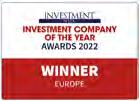


Important information
The value of investments and the income from them can go down as well as up, so you may get back less than you invest. Investors should note that the views expressed may no longer be current and may have already been acted upon. Changes in currency exchange rates may affect the value of an investment in overseas markets. This trust can use financial derivative instruments for investment purposes, which may expose them to a higher degree of risk and can cause investments to experience larger than average price fluctuations. The shares in the investment trust are listed on the London Stock Exchange and their price is affected by supply and demand. The investment trust can gain additional exposure to the market, known as gearing, potentially increasing volatility. This information is not a personal recommendation for any particular investment. If you are unsure about the suitability of an investment you should speak to an authorised financial adviser.
The latest annual reports, key information documents (KID) and factsheets can be obtained from our website at www.fidelity.co.uk/its or by calling 0800 41 41 10. The full prospectus may also be obtained from Fidelity. The Alternative Investment Fund Manager (AIFM) of Fidelity Investment Trusts is FIL Investment Services (UK) Limited. Issued by Financial Administration Services Limited, authorised and regulated by the Financial Conduct Authority. Fidelity, Fidelity International, the Fidelity International logo and F symbol are trademarks of FIL Limited.
ADVERTISING PROMOTION
UKM0223/381031/SSO/0523
NetAssetValue−2.0%19.1%8.0%18.1%9.9% SharePrice−4.1%22.8%11.3%18.6%7.8% FTSEWorldEuropeex-UKTotal ReturnIndex−7.8%15.0%7.9%13.8%4.7% Jan 2018Jan 2019 Jan 2019Jan 2020 Jan 2020Jan 2021 Jan 2021
Jan 2022 Jan 2022
Jan
-
-
2023 To find out more visit www.fidelity.co.uk/europe
The 80s and 90s market stars which could have made you a fortune
Investing in these companies through thick and thin over many years would have generated huge returns
Retiring as a millionaire has been the dream of many people for years. In the fanciful world of ‘what if’ chats over a pint, it didn’t matter how you did it, the endgame is what mattered, not the journey. Buying that Ferrari, taking luxurious cruises around the Caribbean, or owning that stately pile in the country was the dream of millions of us, and we played the pools or bought National Lottery tickets in the vague hope that it could be us.
Investment is different, lodged largely in the real world where discipline, not daydreaming, is far more important to meeting your goals. Yet astonishing returns are possible, with preparation, method and, above all, plenty of time.
If you’d had the foresight to put £5,000 into what in the early 1980s was a fairly obscure mining company trading for pennies then you could have an investment worth nearly £50 million today.
It has become commonplace to read stories of early investors, even ordinary folk, in the big disruptors of recent decades, like Apple (AAPL:NASDAQ), Amazon (AMZN:NASDAQ) and Tesla (TSLA:NASDAQ), becoming very wealthy by mainstream standards.


In just the past 10 years these three stocks have returned an average 25%, 23% and 53% a year respectively. Put another way, for every £1,000 invested in these three companies a decade ago, you would have approximately £9,300, £7,900 and more than £70,000.
BILL GATES, THE MILLIONAIRE MAKER
There are other even more eye-popping stories. Take Microsoft (MSFT:NASDAQ), for example. As early as the mid-1970s, founders Bill Gates and Paul Allen knew that computers were soon to transform the world, a time when for most people, a top-loader video recorder or Atari games console would soon represent the very bleeding edge of
consumer technology.
Gates and Allen founded Microsoft in 1975, and over the next decade they developed software so rapidly and life-changing, that investors wanted in. The Seattle-based firm went public in 1986 at a then $777 million valuation and, according to legend, Gates became the world’s youngest billionaire within a year.
But it would be wrong to presume that such returns are restricted to privileged institutions and insiders. The explosion of personal computers for all has been so successful, and the company has grown so valuable that thousands of ordinary investors might today be millionaires.
According to Nasdaq, had you invested $1,000 in Microsoft at its IPO, you would have acquired 47 shares at $21 per share. Adjusting for nine stock splits over the decades (designed to keep the stock within reach of people like you and me), you’d have 13,536 shares today with a cost basis of $0.0729 per share.
Given that Microsoft now trades at $264.60, Shares’ back of notebook calculations implies a share price return of 362,862%.
In dollar terms, that $1,000 investment in 1986 would be worth almost $3.63 million today.
It gets better too, because Microsoft has paid
Feature: Successful UK stocks 24 | SHARES | 09 February 2023
dividends for two decades now, so assuming you’d taken that cash distribution, but never sold a single share along the way, you’d have also received an estimated $341,513 in income, says Nasdaq.
OK, you’ve probably read similar stories about other big US companies and their earth-shattering stock market returns. But it is a fallacy to think that investors have needed to embrace overseas companies to have struck stock market gold in this way.
As Shares’ findings show, holding stakes in businesses such as Greggs (GRG), Games Workshop (GAW), Berkeley (BKG) and Jet2 (JET2:AIM) might well have made you a millionaire, even from a relatively modest investment of £5,000, had you held them since they floated and reinvested dividends.
One stock, mining firm Antofagasta (ANTO), would have made you a fortune in the tens of millions, £48.15 million to be precise. It was penny stock in 1982 and has paid some generous dividends along the way.
UK-based manufacturers, like BAE Systems (BA.), Renishaw (RSW) and Victrex (VCT), have also delivered the kind of returns needed to make someone rich. So much for the ‘Britain doesn’t make anything anymore’ brigade.
Stars of the 80s
80s MARKET STARS WHICH MADE YOU RICH

Shares’ search was simple; we looked for companies worth more than £1 billion today with the kind of long-term returns record that would have given investors a decent run at becoming a millionaire from a single stock. This is not meant to be a complete list, and there are all sorts of variables to factor in, but a consistent theme is time… a great friend to the sensible investor.
Let’s look a few examples, and where better to start than Tyneside baker-turned-food on the go provider Greggs. One of Britain’s best-loved brands, modern-day Greggs has more than 2,200 outlets nationwide, selling everything from fresh sandwiches and savouries to affordable coffees, breakfasts, confectionery and pizza slices. Today’s
Feature: Successful UK stocks 09 February 2023 | SHARES | 25
Produced from VICTREX™ PEEK polymer, one of the highest performing thermoplastics in the world
Antofagasta 48,149,700Jul,1982 Ashtead 6,361,700Dec,1986 Berkeley 3,684,580Jul,1984 Greggs 3,173,000May,1984 Jet2 1,543,215Dec,1988 Renishaw 809,200Jun,1983 BAE Systems 643,435Feb,1981
Company
Value of £5,000 investment at flotation today (£)
Date it joined the stock market
Table: Shares magazine • Source: Refinitiv based on total return since joining the stock market to 3 February. Note: does not include dealing or investment platform fees
Greggs also retails healthier options including gluten-free, vegan-friendly and lower calorie products including the now-iconic vegan sausage roll.
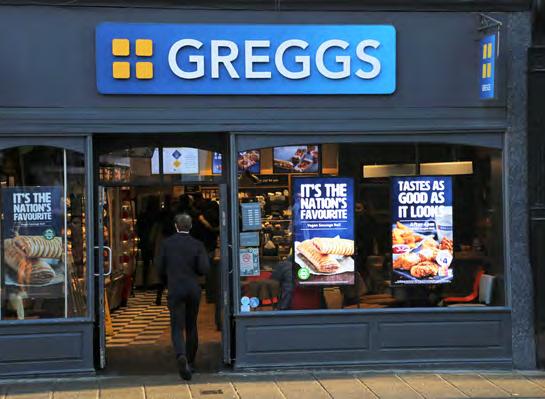
In the four decades since it joined the stock market it has weathered multiple recessions, Black Wednesday (when the UK fell out of the European Exchange Rate Mechanism, or ERM), long-term governments of both red and blue hue, the dot com boom and bust, the global financial crisis, massive changes to how we all live and work and a worldwide pandemic.
Wags might say a tin hat would be more emblematic of its back story than its iconic sausage roll.
Yet, here it still stands, and what a fantastic investment it has been along that seemingly rocky road. If you’d invested £5,000 at the time of the stock market listing in 1984, that outlay would have grown into nearly £3.17 million if you’d reinvested all dividends, according to Refinitiv data, demonstrating the almighty power of compounding.
Yet even if you had needed the income to live on, the share price growth alone over that period has been incredible, increasing more than 20-fold.
Sure, it faces challenges, as Shares explained in detail late last year, yet the business is, arguably, stronger than it has ever been.
FLYING HIGH
Let’s look at another popular business with UK consumers, and increasingly again, with investors… Jet2. From freight airline (it made much of its

money early on flying flowers just-in-time to retailers) to holidays and cheap European flights operator, the old Dart Group, as it was called previously, has proved an (almost) unrelenting success with consumers and investors.
Focusing on the latter, shareholders from day one on the stock market have enjoyed an astonishing 30,864% total return, says Refinitiv. Put that another way, a £5,000 investment back then would today valued at more than £1.54 million.
True, Jet2 has experienced several false dawns in its Covid recovery, yet the brand has earned numerous plaudits from the public for the way it put customers first during the Covid-19 pandemic, something not all travel companies can necessarily say. That’s important from an investment point of view going forward, but so too has been management’s exceptional handling of company finances.
With the stock up 33% so far in 2023, investors appear to see that recovery continuing through the rest of this year and beyond as it takes market share from rivals for whom public opinion is, shall we say, less positive, and others that have not survived at all.
THE HALF A MILLION POUND PIZZA AND OTHER 90S STARS
Now let’s look at the returns of Domino’s Pizza (DOM), which has been on the stock market the fewest number of years of any of our selected stocks, having joined just before the millennium in November 1999.
While managing enormous change over the
Feature: Successful UK stocks 26 | SHARES | 09 February 2023
Shareholders from day one on the stock market have enjoyed an astonishing 30,864% total return”
Stars of the 90s
years as consumers embraced home delivered dinners, Domino’s has adapted to and, in some cases led, these shifts since becoming the master UK and Ireland franchise for its US-listed parent.

The shares would not have made you a millionaire from a £5,000 original investment, though that capital stake would today be worth £547,310, a mightily impressive 10,946% total return. To have made a million your untouched day one investment would have had to be at least £9,136.
What we hope readers will take away from
this exercise in hindsight is the power of time to help build wealth. As the Sage of Omaha, Warren Buffett says, ‘only buy something that you’d be perfectly happy to hold if the market shut down for 10 years.’
Fundsmith Equity’s (B41YBW7) Terry Smith runs his hugely popular fund along similar lines, and tells investors to ‘buy good companies, don’t overpay, then do nothing.’ It’s an investment ethos that has been sorely tested over the past 15-months. It is worth remembering that nothing stays the same for ever, the world turns, and things change, sometimes for the better.
‘Successful investing takes time, discipline, and patience,’ says Buffett. ‘No matter how great the talent or effort, some things just take time: You can’t produce a baby in one month by getting nine women pregnant.’
DISCLAIMER: The author of this article (Steven Frazer) owns shares in Fundsmith Equity.
 By Steven Frazer News Editor
By Steven Frazer News Editor
Feature: Successful UK stocks 09 February 2023 | SHARES | 27
Games Workshop 1,396,530Oct,1994 JD Sports Fashion 608,230Oct,1996 Domino's Pizza 547,310Nov,1999 AstraZeneca 231,098May,1993 SSE 202,506Jun,1991 Victrex 130,566Dec,1995 Anglo American 130,233Dec,1990 National Grid 104,831Dec,1995
Company
Value of £5,000 investment at flotation today (£)
Date it joined the stock market
Table: Shares magazine • Source: Refinitiv based on total return since joining the stock market to 3 February. Note: does not include dealing or investment platform fees
Revealed: the most popular stocks and funds for people drawing on their pension
There are a few interesting additions and omissions beyond classic income-paying stocks and funds
Investors drawing down their pension only have selected exposure to growth stocks and in general they are sticking to incomegenerating shares and funds. This is according to analysis of AJ Bell’s customer holdings by Shares

Many people are living for longer and are keeping their pension invested in the market in the hope of achieving capital growth as well as income. Based on AJ Bell’s customer behaviour this doesn’t extend to putting money into overseas listed stocks such as Tesla (TSLA:NASDAQ) and Apple (AAPL:NASDAQ) which are far more popular among investors who are still building up wealth in their pension.
Instead, FTSE 100 companies are among the preferred ways to maintain exposure to the market for people in drawdown. This can be explained by the index featuring many generous dividend payers, as evidenced by the likes of Lloyds (LLOY), Shell (SHEL) and BP (BP.) being among the top holdings for AJ Bell customers already dipping into their pension pot.
EXPOSURE TO RISKIER INVESTMENTS
What might come as a surprise is the popularity of Scottish Mortgage Investment Trust (SMT) among people taking money from their pension to pay the bills. It’s the top holding for AJ Bell SIPPs (self-invested personal pensions) by number of customers, across both those taking money out of their pot and those who are not yet in drawdown.
It means a lot of people in retirement are exposed to an investment vehicle that has higher risk holdings. Scottish Mortgage aims to invest in the big companies of tomorrow and isn’t afraid to hold stocks that trade on high valuations. It also has large exposure to privately-owned businesses.
Fundsmith Equity Fund (B41YBW7) is also a
ScottishMortgage
Lloyds

GSK
FundsmithEquityFund
Legal&General
BP
Vodafone
Aviva
NationalGrid
Unilever
RioTinto
AstraZeneca
CityofLondonInvestmentTrust
Table: Shares magazine • Source: AJ Bell
Feature: Drawing on your pension 28 | SHARES | 09 February 2023
Most popular stocks and funds for AJ Bell SIPP customers in drawdown
Shell Haleon
popular holding for SIPP holders across both those in drawdown and those who are not. The Terry Smith-run collective invests in what it calls ‘quality growth’ companies. These are typically more profitable businesses than a lot of the holdings you’d find in Scottish Mortgage.
As both funds pay a tiny dividend, it seems as if investors in drawdown are attracted principally to their growth potential. Smith has previously argued that anyone holding his fund who wants to generate an income should simply sell some of the units to raise some cash.

NO SURPRISE TO SEE A RELIABLE INCOME PAYER
Less surprising is the popularity of City of London Investment Trust (CTY) among people in drawdown. It invests principally in large UK-listed companies and a 4.7% yield is likely to be the key attraction for many retirees. That and the fact it has raised its dividend every year since 1966, suggesting that many investors view it as one way to obtain a growing stream of income.
Vanguard’s LifeStrategy fund range has proved a big hit among investors still in the accumulation phase of their life, with many AJ Bell SIPP customers holding the 80% and 100% equity versions. But that popularity doesn’t translate to those already drawing down their pension.
A traditional asset allocation model for investors has been to hold 60% of a portfolio in equities and 40% in bonds. This is the structure of Vanguard LifeStrategy 60% (B3TYHH9), yet this fund is way down the list in terms of popularity for AJ Bell customers in drawdown. Even the idea that one seeks a greater weighting to bonds in retirement isn’t reflected in the product choices, with Vanguard LifeStrategy 40% – being split 40%
equities, 60% bonds – is even less popular when looking at the AJ Bell customer holdings.
TRACKER FUNDS A DEFAULT CHOICE
Tracker funds are the default choice for many investors, particularly those seeking an easy way to get exposure to markets around the world. That might explain why so many AJ Bell SIPP customers not yet in drawdown hold such funds as iShares Core FTSE 100 ETF (ISF) and Fidelity Index World (BJS8SJ3). However, this broad approach doesn’t feature as much in the portfolios of investors already taking money out of their pension. In general, these types of customers appear to prefer individual stocks or investment trusts/funds that have a certain style or approach. For purposes of this article, we have excluded AJ Bell’s own fund range from the analysis of customer holdings.
When looking at the broader investment trust and fund holdings, those leaning on their pension in retirement are more likely to hold something run by a well-known fund manager such as the Nick Train-managed Finsbury Growth & Income Trust (FGT) or a specialist in a certain part of the market like HICL Infrastructure (HICL)
DISCLAIMER: AJ Bell owns Shares magazine. The author owns shares and fund units in AJ Bell, Fidelity Index World and Fundsmith Equity Fund. Tom Sieber who edited this article owns shares in AJ Bell.
 By Daniel Coatsworth Editor
By Daniel Coatsworth Editor
Feature: Drawing on your pension 09 February 2023 | SHARES | 29
VIDEOS
WATCH RECENT PRESENTATIONS
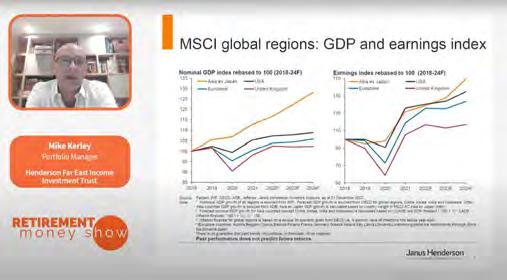

Henderson High Income Trust
David Smith, Portfolio Manager
Henderson High Income Trust (HHI) owns a diversified selection of larger and smaller companies as well as being able to invest in fixed income assets to achieve a high dividend income as well as maintaining the prospect of capital growth.
Henderson Far East Income Investment Trust




Mike Kerley, Portfolio Manager
Henderson Far East Income Investment Trust aims to provide a high level of dividend as well as capital appreciation from a diversified portfolio of investments traded on the Pacific, Australasian, Japanese and Indian stock markets.
First Class Metals PLC
Marc Sale, CEO
First Class Metals PLC is a minerals exploration company focused on proving and developing the potential of their flagship property North Hemlo as well as exploration of the Esa, Sugar Cube, McKellar, Magical, Enable and Coco East Block, in total 180km² in the Hemlo gold mines region in the Wawa-Abitibi Gold Belt of Ontario, Canada.
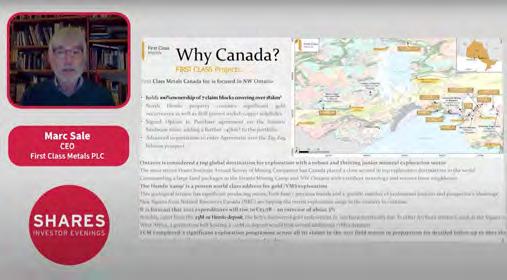
Visit the Shares website for the latest company presentations, market commentary, fund manager interviews and explore our extensive video archive.
CLICK TO PLAY EACH VIDEO SPOTLIGHT WEBINAR www.sharesmagazine.co.uk/videos
and Vodafone are both struggling to dial up growth –here’s why
Telecoms firms’ total returns over 20 years are distinctly unimpressive
Here’s the good news for investors in Vodafone (VOD) and BT (BT.A): over the past 20 years the pair have paid out a cumulative 362p combined in dividends per share.
For someone holding 1,000 shares in each company the dividends paid add up to £1,682.90 for Vodafone and £1,992.30 for BT. The bad news is that over the same timeframe the shares have fallen 21.6% and 23.6% in value respectively.
This explains the distinctly unimpressive 20-year total returns (with dividends reinvested) of 84.8% for BT and 126.8% for Vodafone. This is dwarfed by the 357% total return from the FTSE 100 over the same two-decade period.
In early February the two companies reported soggy growth in their financial third quarters, both running until 31 December 2022. So, what has gone so badly wrong for these two telecoms firms and are they just 20th century businesses which don’t really belong in the 21st century?
Something both companies have in common is a lot of debt and that’s putting their ability to sustain dividends, required to compensate shareholders for the lack of any progress in the share price, to the test.
As at the end of 2022 BT’s net debt stood at more than £19 billion and Vodafone’s own net borrowings, at the end of the September, came in at more than £45 billion. This indebtedness reduces the ability of both firms to invest for future growth – BT also must spend large sums upgrading broadband infrastructure through its Openreach division and servicing large, historic pension liabilities.
Numis analyst John Karidis says BT keeps cutting

Total return index, rebased to 100
Openreach fibre to the premises prices, in part to hurt rival smaller networks, while at the same time raising consumer prices to pay for Openreach’s fibre to the premises build. Sky is taking advantage of this trend because it can raise its own prices but keep them below BT’s because it doesn’t have to pay for the fibre rollout.
Vodafone’s big debts partly reflect the €18 billion deal to acquire rival Liberty Global’s (LBTY.A:NASDAQ) European businesses in 2019. Using acquisitions as a shortcut to growth hasn’t worked and the architect of that deal, Nick Read, departed at the end of 2022 as the board and shareholders lost patience with his inability to whip the business into shape.
While there was little sign the market was sorry to see Read go, it has left a leadership vacuum and increased the risk of drift in the short term for the business while it searches for a new permanent CEO.
Both Vodafone and BT operate in a highly regulated industry. In Vodafone’s core German market, the introduction of new telecommunications legislation in 2021 made it easier for consumers to cancel contracts and harder for providers to automatically renew them.
All these issues mean that BT and Vodafone have become complex and frustrating investments where the high dividend yields (5.8% and 8.5% respectively) certainly do not compensate for the risks involved. For the tens of thousands of investors holding these stocks, it’s time to consider if they should remain in your portfolio.
Editor’s View: Tom Sieber 09 February 2023 | SHARES | 31
BT
2005201020152020 0 200 400 BT Vodafone FTSE 100
Source: Refinitiv
Shine as an investor: six golden rules to help you on the path to success
This market wisdom could help you avoid obvious pitfalls and stick to your plan

Ask someone who has been investing for a while and there’s a good chance they will discuss the lessons learned along their investment journey. Many will reflect on their experiences and say that they wish they’d had a clear goal from the start as it would have saved them a lot of mistakes along the way.
Whether you’re new to investing or experienced, there is a lot to gain from following a few golden rules. Here are six of them to sharpen your approach.
HAVE A PLAN AND STICK TO IT
With thousands of stocks, funds and bonds available on the market, some investors make the mistake of having a scattergun approach to investing. It’s easy to pick the first investment you see without any thought to whether it’s right for you or what part it might play in a diversified portfolio.
It’s much better to sit down and work out what you want to achieve with investing before jumping in and making transactions.
Establish your investment goal. For example, if you’re putting money into a Lifetime ISA with the hope of saving up enough for a property deposit in five years’ time, you might not want to put money into higher risk investments. That’s different to someone who wants to squirrel away their money for 20 years as they have time on their side to ride the ups and downs of the market.
If you’re goal is to put a set amount of money into the stock market every month to build up wealth, try and stick to this plan even when markets are going through a bad patch as your money will go further if prices of stocks, funds and bonds are lower.
If you’re someone who is happy to trade in and out of shares, write down a plan for when you’re going to exit and stick to it. If things don’t work out as planned, move on. It’s all about having the right strategy for you.
DON’T PUT ALL YOUR EGGS IN ONE BASKET
Diversification is important when investing. If you only hold one or two individual investments, then the impact of a sudden market shock could destroy the value of your portfolio. Someone drawn in by the meme stock craze, for example, who bought shares in video games seller GameStop (GME:NYSE) at their height and nothing else would now be sitting on a loss of more than 70%. It you’d put money into bitcoin when it was trading above $50,000 your investment would have halved in value as the price has since dropped.
By investing in a spread of different holdings (anything up to 10 or 15 is probably a good rule of thumb) and a range of different asset types, you spread risk and have a cushion in case one or more holdings doesn’t work out as expected.
Investment trusts, funds or ETFs (exchangetraded funds) are a means of achieving diversification even if you do not have large amounts of cash at your disposal. And if you don’t want to or cannot hold bonds, commodities, property or other assets directly, it is still possible to get exposure to these asset classes indirectly through one of these vehicles.
Feature: Six golden rules 32 | SHARES | 09 February 2023
DO YOUR RESEARCH
Before you invest in anything it is crucial to do your research. You should not let this paralyse you into inaction. You don’t need a PhD in biology before you invest in pharmaceutical giant GSK (GSK), for example. But at the very least you should confidently be able to answer the question: ‘How does it make money?’.

The reason is investors have probably already discounted the news in advance. What is important therefore is how a company delivers against expectations.
Expectations are captured by consensus sales and profit estimates provided by analysts and compiled by data groups such as Refinitiv. Some companies provide consensus analyst estimates on the investor section of their website or reference them on earnings updates.
Alternatively, they can be found on paid-for services such as Sharepad and Stockopedia.
Michael Mauboussin a head of research at US investment bank Morgan Stanley argues investors should always start with trying to figure out what is already factored into a share price.
For interested readers Mauboussin wrote a book about it called Expectations Investing.
If you can’t, then how can you have any confidence in its ability to do so in the future?
This is the major determining factor in whether an investment will turn out to be a success or a failure.
Big companies tend to have a lot of useful information on their websites – although clearly their take won’t be an objective one.
Other sources of information are the financial press, including Shares, as well as regulatory news updates. Smaller companies also present at events aimed at ordinary investors, where you can put questions to senior management.

The need to make informed decisions applies to funds too – you should have a clear idea of how they plan to deliver returns for holders. It’s also worth looking at how stocks or funds have performed in the past. It’s no guarantee of future performance but it still provides useful context for your investment decisions.
TRY TO UNDERSTAND WHAT THE MARKET THINKS
Often a share price will move in the opposite direction to what might be expected after giving what looks like on first glance ‘good’ or ‘bad’ news.
THINK LIKE A BUSINESS OWNER
It is easy to get caught up in the excitement of stock prices winging around on a computer screen. But shares represent partial ownership of a company and have a claim on all future profit and cash flow.
This means investing is more akin to a marathon than a sprint and success should be measured over years not months. Thinking about the factors influencing the long-term success of a business is therefore more important than short-term gyrations in the share price. In the long run the share price will follow profits.
Developing a business owner mindset encourages rational thinking and provokes questions which lead to a better fundamental understanding of a business and its prospects.
Feature: Six golden rules 09 February 2023 | SHARES | 33
Some of the world’s best companies such as Coca Cola (KO:NYSE) have been around for more than 100 years and that didn’t happen by accident. It required making investment decisions which were expected to pay off in the long run, even if it meant hurting profits over the short term.

Some of the best investors are also business owners. Famed investor Warren Buffett says he is a better investor because he is a businessman and a better businessman because he is an investor.
MONITOR YOUR INVESTMENTS (JUST NOT EVERY HOUR OF THE DAY)
It is important to stay abreast of news and events which may impact the value of companies
in your portfolio. Regular earnings updates are usually scheduled so setting alerts on the relevant date is a sensible thing to do.
Some investment platforms offer services which allow investors to set alerts if new news comes out or if there are unusually high trading volumes.
Broker notes can also have a big impact on share prices and there are services such as Research Tree which give retail investors access to them. Understanding the bull and bear case is useful for putting upgrades and downgrades into context.
Writing down the investment case when you first buy shares can be extremely helpful for gauging how an investment is evolving relative to original expectations.

Most investors are better at the buying side of things than the selling, so gathering data to show whether a holding is progressing or faces a deteriorating outlook is a good discipline.
It is better to stay steer clear of online message boards and rumours which can affect share prices but often tend to be short-lived and an unhelpful distraction.
By Daniel Coatsworth, Martin Gamble and Tom Sieber
Feature: Six golden rules 34 | SHARES | 09 February 2023
FIRST-TIME ISA: HOW TO START YOUR INVESTMENT JOURNEY Out on 16 February IN NEXT
WEEK'S SHARES
Case Study: How I invest
Taking the plunge and making money from the markets full-time
Maths graduate Sam enjoys the flexibility which gives him time to focus on family, sport and outdoor pursuits
In 2019, building on his experience as a maths graduate and his career in investment banking and private equity, Sam started investing full-time.
Having recently moved out of London with his partner and two sons, he balances managing his portfolio with maintaining his new property, outdoor pursuits and a variety of sports including golf, tennis, hockey and cycling.

He says: ‘I really enjoy the hunt for great investment opportunities as well as reading and utilising my analytical background as a maths graduate and investment banking analyst.
‘There is always something new and different to discover and learn, and I can work anytime from anywhere with an internet connection, so it provides great flexibility to focus on my family and other interests.’
A FULL-TIME INVESTOR
Sam, now in his 40s, started working for a private equity firm in 2011 which was centred on buying listed companies and taking them off the market. His role involved analysing these listed businesses with a view to buying the whole company. It was upon leaving that role three years ago that he took the leap and started to make his money from the
SAM’S INVESTMENT PROCESS
SIX KEY QUESTIONS HE ASKS BEFORE MAKING AN INVESTMENT:
Why is it a good business?
Why does the opportunity exist?
Who am I partnering with (in other words who are the management, board and other shareholders)?
What happens when something goes wrong?
What biases are impacting my business appraisal?
What is the ‘no-brainer’ value proposition?
09 February 2023 | SHARES | 35
markets instead.
As he explains: ‘Having built an income stream from my investment subscription and professional client advisory business, my investment goals are focused on long-term compounding of capital to fund retirement and discretionary purchases.’
Sam exclusively invests in individual stocks in the UK, North America and Europe where he feels he has a handle on the cultural and legal frameworks.
‘This is already an enormous opportunity set for one person and while I don’t focus on specific sectors, I do not invest in banks or financial institutions because they are too opaque, asset management businesses or investment funds because I am opposed to the business model, insurance which I don’t understand well enough and property, which is a specialism in its own right,’ he explains.
Sam’s has a reasonably ambitious targeted return. ‘I have an overall goal of compounding at 15% of more annually,’ he says.
To achieve this, he aims for a balance between opportunities where he thinks the share price could at least double on a two or three-year timeframe (accepting there will be volatility along the way) and more established, less volatile investments which he thinks are ‘fundamentally undervalued’ and can offer steady growth over the medium and longer term.
MOST AND LEAST REWARDING INVESTMENTS

Among the current stocks in his portfolio, the one he is most pleased with is AIM-quoted biopharmaceutical firm Avacta (AVCT:AIM). Sam says the company recently announced ‘exceptional clinical trial results in the development of a platform to provide chemotherapy without side-effects’.
However, the biggest return he has ever scored was from an investment in Canadian bioenergy pellet producers and supplier Pinnacle Renewable Energy.
He benefited from the company fixing some of its short-term operational issues in its distribution business. Having subsequently moved to an expansion phase, it was then taken over by energy firm Drax (DRAX), described by Sam as a ‘strategic operator’, for an enterprise value of more than £400 million in 2021.
Despite employing his investment framework and bringing his professional experience to bear, Sam has seen some of investments go badly wrong. ‘My worst investment was mCloud Technologies (MCLD:CVE), a business with an asset management platform to enable energy producers and infrastructure and building operators to optimise their energy usage.
Case Study: How I invest 36 | SHARES | 09 February 2023
mCloud Technologies (CDN$) 20192020202120222023 0 5 10 15 Chart: Shares magazine • Source: Refinitiv Avacta (p) 20192020202120222023 0 50 100 150 200 250 Chart: Shares magazine • Source: Refinitiv
‘I completely overestimated the management’s understanding of per share intrinsic value as they diluted shareholders time after time with a variety of instruments, underestimated the length of time to roll out the solution extensively and failed to sell anywhere near quickly enough despite red flags. It was a huge learning experience.’ The shares have fallen by more than 80% in value since 2019.
TAKING A RATIONAL VIEW
Sam tries to maintain a sense of perspective if his investments go wrong. ‘I immediately remind myself that making mistakes is the only guarantee in investing and not to get emotional. All my investment decisions are based on a probabilityweighted expected return that specifically incorporates a scenario of what happens when something goes wrong.
‘The focus is acknowledging and accepting that sometimes the probability goes against you and then analysing whether the downside scenario was wrong. If it was, I’m trying to understand what was foreseeable and what wasn’t to build pattern

recognition for future opportunities.’
Through his time in the private equity industry Sam has learned to put some emphasis on downside protection, investing with a margin of safety or, in other words, only buying something when it is priced by the market at less than its intrinsic value, doing proper homework and identifying areas where both the business and management can improve.
‘That is the basis of my approach that I have refined to suit a publicly listed and slightly more diversified portfolio,’ he says.
DISCLAIMER: Please note, we do not provide financial advice in case study articles, and we are unable to comment on the suitability of the subject’s investments. Individuals who are unsure about the suitability of investments should consult a suitably qualified financial adviser. Past performance is not a guide to future performance and some investments need to be held for the long term. Tax treatment depends on your individual circumstances and rules may change. ISA and pension rules apply.
09 February 2023 | SHARES | 37
Case Study: How I invest
A unique investment philosophy
value overlooked or misunderstood by the market Past performance should not be seen as an indication of future performance. The value of your investment may go down as well as up and you may not get back the full amount invested. Issued by Asset Value Investors Ltd who are authorised and regulated by the Financial Conduct Authority. Discover AGT at aviglobal.co.uk AVI-Global-Trust AVIGlobalTrust @AVIGlobalTrust
Finding
How compounding works in investing and why it is important
A £1,000 investment which doubles every year would be worth £1 million in 10 years
Compounding is a term which gets bandied about a lot in the investment world, but it can be a tricky subject to understand. This article explains why it is important to investing and how it works.
Conceptually, James Dow of Baillie Gifford and co-manager of the Scottish American Trust (SAIN), known as SAINTS summed compounding up very well when he likened it to the effect of a snowball rolling down a long hill: ‘The further it travels, the faster it gains in size.’
REINVESTING INCOME IS KEY TO COMPOUNDING
Let’s break down the mechanics of compounding to understand its relevance and importance to investing.
When an investment is made into a cash savings account or dividend paying stocks and shares, it will eventually lead to a decision about what to do with the income received.
It is the reinvestment of income which lies at the core of compounding.
A simple example will show the effects of reinvesting compared with not reinvesting.
Let’s say Jane and John each buy 200 shares in food retailer Sainsbury’s (SBRY) at a price of 245p. The company pays a dividend of 12.6p per share equivalent to around £25 in hard cash, representing a yield of 5% (12.6p divided by 245p multiplied by 100).
Jane elects to reinvest her dividends while John takes the cash. Before reading any further, take a moment to guess what difference this might make to their relative wealth over 20 years.
The first cash dividend will buy another 10 shares, so in year two Jane now owns 210 shares. Let’s also assume the company increases the dividend by around 5% a year. So, in year two the dividend paid is 13.2p per share (12.6p multiplied by 1.05).
Compounding: reinvesting and receiving dividends compared
Compounding: reinvesting and receiving dividends compared
Compounding: reinvesting and receiving dividends compared
Education: Compounding 38 | SHARES | 09 February 2023
Year 1 54051525 Year 2 59454026 Year 3 65556728 Year 4 72159629 Year 5 79462531 Year 6 87565732 Year 7 96468934 Year 8 1,06172435 Year 9 1,16976037 Year 10 1,28879839 Year 11 1,41883841 Year 12 1,56288043 Year 13 1,72092445 Year 14 1,89597048 Year 15 2,0871,01950 Year 16 2,2991,07052 Year 17 2,5321,12355 Year 18 2,7891,17958 Year 19 3,0721,23861 Year 20 3,3831,30064 Total £3,383 £1,300 £833 £2,133(sharesand dividends) Jane (dividends reinvested) (£) John (£) John's dividend income (£)
Table: Shares magazine • Source: Shares magazine Note: this is a hypothetical example and does not include fees.
Year 1 54051525 Year 2 59454026 Year 3 65556728 Year 4 72159629 Year 5 79462531 Year 6 87565732 Year 7 96468934 Year 8 1,06172435 Year 9 1,16976037 Year 10 1,28879839 Year 11 1,41883841 Year 12 1,56288043 Year 13 1,72092445 Year 14 1,89597048 Year 15 2,0871,01950 Year 16 2,2991,07052 Year 17 2,5321,12355 Year 18 2,7891,17958 Year 19 3,0721,23861 Year 20 3,3831,30064 Total £3,383 £1,300 £833 £2,133(sharesand dividends) Jane (dividends reinvested) (£) John (£) John's dividend income (£)
Table: Shares magazine • Source: Shares magazine Note: this is a hypothetical example and does not include fees.
The further it travels, the faster it gains in size”
Year 1 54051525 Year 2 59454026 Year 3 65556728 Year 4 72159629 Year 5 79462531 Year 6 87565732 Year 7 96468934 Year 8 1,06172435 Year 9 1,16976037 Year 10 1,28879839 Year 11 1,41883841 Year 12 1,56288043 Year 13 1,72092445 Year 14 1,89597048 Year 15 2,0871,01950 Year 16 2,2991,07052 Year 17 2,5321,12355 Year 18 2,7891,17958 Year 19 3,0721,23861 Year 20 3,3831,30064 Total £3,383 £1,300 £833 £2,133(sharesand dividends) Jane (dividends reinvested) (£) John (£) John's dividend income (£)
Table: Shares magazine • Source: Shares magazine Note: this is a hypothetical example and does not include fees.
Education: Compounding
That means in the second year the payout will be £27.70 (210 shares multiplied by 13.2p).
If the shares remain unchanged at 245p, Jane’s shares will be worth around 11% more than when she started. For the rest of the illustration, we will assume that the share price rises in line with the growth in the dividend, at 5% a year.
As the table shows after 20 years Jane’s investment would be worth £3,383 or roughly seven times her original £490 investment into Sainsbury’s. This works out at a compound annual return of 10% a year. The original investment is doubling roughly every seven years.
However, John didn’t get a compounding benefit so his 200 shares would only be worth £1,300 (650.1p multiplied by 200). In the intervening period he would have received dividends of 416p, totalling £833 (416p multiplied by 200 shares). The total value of his shares plus dividend income is therefore £2,133.

Meanwhile Jane has been able to purchase 320 new shares (more than doubling her original
THE MORE EXPERIENCED INVESTOR

This is the first in a series of articles aimed at building your knowledge if you have at least some experience of investing. Look out for the next part in the series in a future issue of Shares.
holding) with cash provided by the company to boost or compound her total investment return. The effect of compounding the dividend income into new shares has resulted in Jane accumulating £1,250 (£3,383 minus £2,133) more wealth than John in this hypothetical example. This is a difference of around 60%. How close was your guess?
By Martin Gamble Education Editor
Eight big tips to beat the taxman this April
How to make the most of your allowances before the tax year end
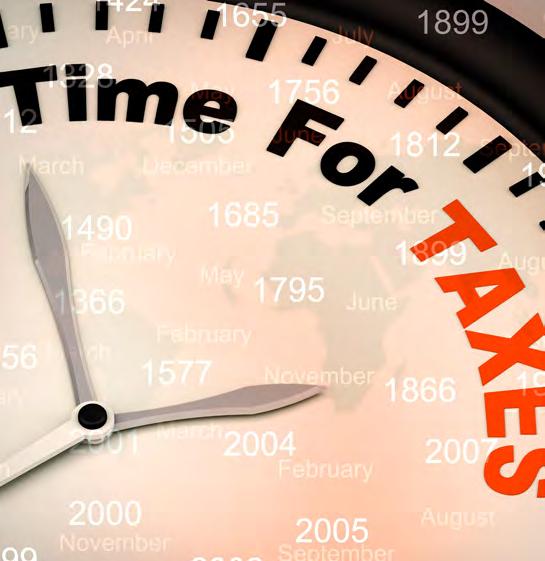
Tax year end is less than two months away, which means it’s time to get your financial affairs in order and make sure you’re making the most of all your allowances and not unnecessarily handing over money to the taxman.
Here’s our checklist of eight things to do before 5 April to make sure your finances are in ship shape condition.
STEP 1 STUFF YOUR ISA AND PENSION
Everyone gets an annual ISA allowance of £20,000 so make sure you’re maximising this as much as possible, as if you don’t use it, you lose it – you
can’t carry forward any unused allowances to future years.
An ISA protects your investments from capital gains, dividend and income tax, so it’s the best place for your investments. Investors with spare money they plan to save and any unused ISA allowance for this year should consider using it before the 5 April deadline.
On top of that most people can put up to £40,000 in their pension each year, so work out if you want to top-up your contributions this year and do it before the end of the tax year. This limit isn’t as immediate, as you can carry forward an unused allowances for up to three years, but it’s still worth considering. Just be aware, anyone with a very high income or who has already started to take taxable income from their pension will have a restricted annual pension limit.
STEP 2 USE YOUR CAPITAL GAINS TAX ALLOWANCE
Any investment gains held outside an ISA or pension will be subject to capital gains tax. Investors can make investment gains of up to £12,300 in the current tax year before they have to pay any tax. Gains over that amount are added to income and if they fall in the basic-rate tax band are taxed at 10% and if they fall in the higherrate tax band are taxed at 20% (an additional 8% is added to the tax rate if the gains are from a second property).
On top of that, the tax free allowance is being slashed from April, meaning that everyone can only make £6,000 of gains before they have to pay tax on them. It means it’s doubly important to consider whether it’s worth cashing in some gains this year, up to the annual limit, so you don’t have to pay tax on them in future years.
You can use something called ‘Bed and ISA’ to realise gains and then funnel investments into an ISA and protect them from tax. You need to check you’ve got some of your £20,000 ISA allowance left, and then use your investment platform’s Bed and ISA service, which means the investment outside of the ISA is sold, the proceeds moved into an ISA and used immediately to purchase the same
40 | SHARES | 09 February 2023 Personal Finance: Beat the taxman
investment within the ISA. Just make sure that you state that you only want to sell enough to realise £12,300 of gains this tax year.
STEP 3 PROTECT YOUR INCOME INVESTMENTS FROM THE TAX GRAB
From April the amount you can earn before you pay dividend tax is also being slashed, from the current £2,000 a year to £1,000. It means lots of people will pay dividend tax where they haven’t before.

This means that it’s more beneficial than ever to put your income-producing investments inside an ISA, to protect them from tax. You can use the Bed and ISA process to move assets into an ISA, but if you have too many investments to move them all in one tax year you should prioritise the ones paying the highest amount of dividends.
it’s important to get as much free Government cash as you’re entitled to.
Pensions benefit from tax relief at 20% for basic-rate taxpayers, but higher and additional rate payers can reclaim an additional 20% or 25% tax relief respectively through their tax return. That means for a basic-rate taxpayer every £1 in your pension only costs you 80p and for a higherrate taxpayer every £1 in your pension only costs you 60p.
Anyone using a Lifetime ISA can also get up to £1,000 of free money from the Government each tax year, if you put in the maximum £4,000 contribution. So, if you have some spare cash you were planning to put into your Lifetime ISA, do it before the tax year end and claim that free cash. Just be aware that you can withdraw Lifetime ISA money once you’ve reached age 60 or earlier to buy your first property, but if you take the money out for any other reason (apart from severe ill health) you’ll pay an exit penalty of 25%.
You should also check that you’re claiming any Government tax-breaks that you’re eligible for, such as the marriage allowance or claiming tax-free childcare, which gives a 20% top-up to money you use for childcare.
STEP 5 AUTOMATE YOUR INVESTING
STEP 4 CLAIM YOUR FREE GOVERNMENT MONEY
Everyone loves free money. Whether it’s tax relief on your pension, the bonus on your Lifetime ISA or ensuring you claim tax breaks that you eligible for,
The end of the tax year is a good time to look back and see how you invested across the year. Were you pretty sporadic and put money in your account in fits and bursts, as you remembered, or were you very methodical. If you sit in the former camp it might be a good idea to set up regular investing. This takes the hassle out of remembering to contribute to your account each month – you’ll automatically deposit money from you bank account into your ISA and then that will automatically be invested in your chosen investment – magic.
Many investment platforms will allow you to start from as little as £25 or £50 a month. You can always pause it one month if you need to skip a month, but it means you don’t have to actively log in and invest money every month.
09 February 2023 | SHARES | 41 Personal Finance: Beat the taxman
STEP 6 WORK OUT YOUR INFLATION BATTLEPLAN
Cash savings rates have risen dramatically this year, but so has inflation. It means that even with higher returns on cash, inflation is eroding a lot of your cash’s value. Everyone needs cash, for easyaccess, for their emergency pot or for short-term spending. But if you have too much you could end up being recklessly conservative – and miss out on potentially larger returns from investing. So, work out what you need in the next five years or as an emergency pot, and see how that stacks up against the amount you’ve got in cash. If you’ve got more than that set aside, think about investing it to generate a potentially higher return.
STEP 7 DON’T FORGET THE KIDS
Lots of parents intend to set up savings accounts for their children and then never get around to it. But if you want to put money into an ISA for them you should use up some of their ISA allowance for this year before you lose it. You can now put up to £9,000 a year into an ISA for each child – very generous. They won’t be able to access the money until they are 18, at which point it automatically turns into a normal ISA and transfers into their name, giving them full access.
Another option is opening a Junior SIPP for your child (or grandchild). You can pay in up to £2,880 each year, with Government tax relief automatically boosting that to £3,600. Your child won’t be able to access the money until they are at least age 57, maybe later if the Government increases the age limit, so it’s a very long-term play.
STEP 8 AVOID A TAX TRAP

The UK tax system is far from simple and it means it’s very easy to slip up and end up paying more tax than you need. Anyone hitting £100,000 of income starts to lose their tax-free personal allowance, at a rate of £1 for every £2 they earn over the threshold. This means that you end up paying an effective tax rate of 60% on this income – very high. By funnelling money into pensions you can bring your income back down below this level and not be hit by the higher tax.
There are lots of other examples: the threshold for child benefit at £50,000, losing your tax-free childcare at £100,000, seeing your Personal Savings Allowance slashed in half if you become a higherrate taxpayer, to name a few. Take a look at your earnings this tax year and see if making a little pension contribution could stop you slipping into a tax trap.
By Laura Suter AJ Bell Head of Personal Finance


42 | SHARES | 09 February 2023 Personal Finance: Beat the taxman
Join Shares in our next Spotlight Investor Evening webinar
on Wednesday 22 February 2023 at 18:00
Hear from these companies for investment ideas
LOWLAND INVESTMENT COMPANY (LWI)

James Henderson, Fund Manager
The Company aims to give shareholders a higher than average return with growth of both capital and income over the medium to long-term, by investing in a broad spread of predominantly UK Companies.
ABERDEEN DIVERSIFIED INCOME AND GROWTH TRUST (ADIG)


Nic Baddeley, Investment Manager
The trust seeks to provide income and capital appreciation through investment in a globally diversified multi-asset portfolio.
POLAR CAPITAL GLOBAL FINANCIALS TRUST (PCFT)

George Barrow, Fund Manager
The five-strong investment team invest solely in financials, scouring the globe and actively investing in developed regions such as the US as well as emerging economies and Asia.
Sponsored by WEBINAR
Click here to register for this free event www.sharesmagazine.co.uk/events
Russ Mould
AJ Bell Investment Director

Markets must keep watching Japan as there are big risks brewing
The country’s central bank is engaged in a titanic struggle with bond and currency markets
The Magnificent Seven may be one of the most famous films, or at least most famous Westerns, ever made, but both the 1960 version (Yul Brynner, Steve McQueen and the rest) and the 2016 remake (with Denzel Washington and Chris Pratt, to name but two) draw heavily on 1954’s Seven Samurai and the work of legendary Japanese film director Akira Kurosawa.
But it is not just in the world of cinema where the West can take inspiration, and learn, from Japan. What is happening in Japan’s financial markets right now could have implications for investors, not to mention central bankers and monetary policy, in London, Washington, Frankfurt and elsewhere, because the Bank of Japan (BoJ) is still locked in a titanic struggle with the Tokyo’s bond and currency markets.
TO INFINITY AND BEYOND
Unlike the US Federal Reserve, the European Central Bank and the Bank of England, the Bank of Japan is yet to raise interest rates and it is yet to officially try to sterilise quantitative easing and launch quantitative tightening, whereby its balance sheet starts to shrink.

The BoJ’s zero-interest-rate policy dates back to 1999 and quantitative easing to 2001. Those dates

should be a clue as to how hard Western central banks might find it to move away from them on a sustained basis, even if stock and bond markets right now appear to be pricing in a golden trifecta of a slowdown in inflation, a peak in interest rates and a soft landing for the global economy.
That would be nirvana indeed. But the BoJ has consistently found it hard, if not impossible, to tighten monetary policy for long and in 2016 it even launched QQE – quantitative and qualitative easing – so it could bring in yield curve control. Under the latter, the BoJ stated it would buy unlimited amounts of Japanese government bonds – and in effect print unlimited amounts of money – to hold the yield on the benchmark 10-year bond below 0.25%.
After six years of that, even Japan began to see some inflation, and the sort of inflation for which
44 | SHARES | 09 February 2023 Insightful commentary on market issues
Source: Bank of Japan, FRED – St. Louis Federal Reserve, Refinitiv data
Japan has yet to tighten monetary policy
The Bank of Japan is yet to raise interest rates”
Insightful commentary on market issues
Japan is finally seeing some inflation
 Russ Mould
AJ Bell Investment Director
Russ Mould
AJ Bell Investment Director

flew out to 0.50% in the blink of an eye. Bond vigilantes continue to test the BoJ’s commitment to defending that new line in the sand.
Source: Refinitiv data
Japan has strived after decades of near-deflation in the wake of the debt-fuelled equity and property bubble that finally popped as the 1980s ended and the 1990s began.
However, there was a cost. The yen began to tank and in late 2022 hit its lowest level against the dollar since 1998, just as the bond market began to rebel at the ongoing QQE and money printing.

MAKE OR BREAK
Something had to give and the BoJ blinked. It raised its cap on the 10-year government bond to 0.50% from 0.25% so it did not have to buy quite so many bonds and print so much money.
But that did not ease the pressure for long. Yes, the yen rallied but the yield on the 10-year bond

The BoJ’s balance sheet already exceeds 100% of GDP so the vigilantes may not give BoJ governor Haruhiko Kuroda much rest, although he steps down at the end of his second, five-year term in early April. The quandary of how best to manage the currency, the national debt, the BoJ’s balance sheet and its government bond holdings may well fall to his successor, especially as Kuroda continues to dismiss out of hand any scope for an exit from zero interest rates or quantitative easing, even if the fight to avoid deflation seems to be less of a worry.
Prime minister Fumio Kishida will make the appointment and he will be aware of the economic and political stakes as policymakers look to keep bond and currency markets at bay, using any tools they have to hand.
Central bankers and political leaders around the world will be watching and learning, too, and no doubt hoping the ending mirrors that of another cinematic classic from Kurosawa.
In Kagemusha, a castle siege is successfully fended off at the Battle of Nagashino with the help of new technology, in this case guns. The attackers are mown down in a hail of bullets. The shadow warrior protagonist, the kagemusha, is killed and his body eventually washed away down a river.
Source: Refinitiv data
Source: Refinitiv data
09 February 2023 | SHARES | 45
The yen has sunk as QE has continued Bond vigilantes are putting the BoJ to the test
policymakers look to keep bond and currency markets at bay, using any tools they have to hand.”
How do I complain about an employer shutting me out of a workplace pension scheme?
Helping with a question about automatic enrolment and how it is supposed to work
My (previous) employer refused to let me ‘opt in’ to the workplace pension scheme early and said I had to wait three months. I believe this is wrong, you should be able to opt in as soon as you wish. Am I correct?
On leaving the employer, my final pay was made up of holiday back pay and a bonus. However, on my final pay slip, the former employer did not pay pension contributions and they appear to have “opted me out” against my wishes. Are they wrong to do that? Should my final pay have included pension contributions from both parties?
What can I do about this? Who should I speak to in the first instance and where do I progress a complaint?
Matt
Tom Selby, AJ Bell Head of Retirement Policy, says:

On your first question, you could potentially have grounds for a complaint if you were eligible to be enrolled in your employer’s workplace pension and they did not take the correct action.
Under automatic enrolment rules, all UK employers are required to offer qualifying staff a pension. To qualify for auto-enrolment you need to be between 22 years old and state pension age (currently 66) and earning at least £10,000 per year.
Those who meet these criteria will be autoenrolled into a pension scheme, with minimum total contributions set at 8% of qualifying earnings (4% from the employee, 3% from the employer
and 1% from tax relief). For 2022/23 qualifying earnings are those between £6,240 and £50,270.
Those who don’t qualify for auto-enrolment are entitled to ‘opt-in’ or join a scheme, although you may not receive an employer contribution.
The rules allow firms to postpone auto-enrolling employees up to three months after your first day of employment or from the point when you meet a certain trigger.
However, if you tell your employer you want to join the pension scheme during this postponement period, they are legally bound to enrol you. If you qualify for auto-enrolment, you will also be entitled to matched employer contributions during this period.
Similarly, if you tell your employer you are leaving but do not opt-out of the pension scheme, they are still required to enrol you based on the minimum criteria set out above.
Before making a formal complaint, you should speak to your former employer in the first instance as they may be willing to resolve the issue.
If they aren’t, as this relates to a possible administration failure in a workplace pension scheme, the most likely avenue is the Pensions Ombudsman.
You can complete the complaints process online. You’ll need details of your complaint, including when it happened and when you became aware of the issue, your supporting documentation, including your initial complaint and any responses you have received, the name, address and contact number of the parties you believe are at fault.
DO YOU HAVE A QUESTION ON RETIREMENT ISSUES?
Send an email to asktom@sharesmagazine.co.uk with the words ‘Retirement question’ in the subject line. We’ll do our best to respond in a future edition of Shares.
Please note, we only provide information and we do not provide financial advice. If you’re unsure please consult a suitably qualified financial adviser. We cannot comment on individual investment portfolios.
Ask Tom: Your retirement questions answered 46 | SHARES | 09 February 2023
@#%!
WHO WE ARE
EDITOR: Daniel Coatsworth @Dan_Coatsworth
DEPUTY EDITOR: Tom Sieber @SharesMagTom


NEWS EDITOR: Steven Frazer @SharesMagSteve
FUNDS AND INVESTMENT
TRUSTS EDITOR: James Crux @SharesMagJames
EDUCATION EDITOR: Martin Gamble @Chilligg
COMPANIES EDITOR: Ian Conway @SharesMagIan






CONTRIBUTORS: Danni Hewson
Laith Khalaf
Russ Mould
Tom Selby
Laura Suter
Shares magazine is published weekly every Thursday (50 times per year) by AJ Bell Media Limited, 49 Southwark Bridge Road, London, SE1 9HH. Company Registration No: 3733852.
All Shares material is copyright. Reproduction in whole or part is not permitted without written permission from the editor.
DISCLAIMER
Shares publishes information and ideas which are of interest to investors. It does not provide advice in relation to investments or any other financial matters.
Comments published in Shares must not be relied upon by readers when they make their investment decisions. Investors who require advice should consult a properly qualified independent adviser. Shares, its staff and AJ Bell Media Limited do not, under any circumstances, accept liability for losses suffered by readers as a result of their investment decisions.
Members of staff of Shares may hold shares in companies mentioned in the magazine. This could create a conflict of interests. Where such a conflict exists it will be disclosed. Shares adheres to a strict code of conduct for reporters, as set out below.
1. In keeping with the existing practice, reporters who intend to write about any securities, derivatives or positions with spread betting organisations that they have an interest in should first clear their writing with the editor. If the





editor agrees that the reporter can write about the interest, it should be disclosed to readers at the end of the story. Holdings by third parties including families, trusts, self-select pension funds, self select ISAs and PEPs and nominee accounts are included in such interests.
2. Reporters will inform the editor on any occasion that they transact shares, derivatives or spread betting positions. This will overcome situations when the interests they are considering might conflict with reports by other writers in the magazine. This notification should be confirmed by e-mail.
3. Reporters are required to hold a full personal interest register. The whereabouts of this register should be revealed to the editor.
4. A reporter should not have made a transaction of shares, derivatives or spread betting positions for 30 days before the publication of an article that mentions such interest. Reporters who have an interest in a company they have written about should not transact the shares within 30 days after the on-sale date of the magazine.
Index 09 February 2023 | SHARES | 47
ADVERTISING Senior Sales Executive Nick Frankland 020 7378 4592 nick.frankland@sharesmagazine.co.uk Main Market Antofagasta 25 Auction Technology9 BAE Systems 25 Berkeley 25 BP 18 British American Tobacco 22 BT 31 CRH 13 Domino's Pizza 26 Drax 36 Games Workshop25 Greggs 25 GSK 16, 33 Haleon 16 Hilton Food 14 Imperial Brands 22 Lloyds 28 Moneysupermarket10 Renishaw 25 Rio Tinto 13 Sainsbury's 38 Shell 18, 28 Tesco 14 TUI 10 Unilever 22 Victrex 25 Vodafone 31 AIM Avacta 36 Jet2 25 Overseas shares Ahold Delhaize 14 Airbnb 11 Airbus 13 Alphabet 13 Amazon 24 Apple 7, 24, 28 Coca-Cola 11, 34 Elevance Health 13 GameStop 32 Iberdrola 13 Liberty Global 31 mCloud Technologies36 Microsoft 13, 24 Pernod Ricard 13 Investment Trusts City of London Investment Trust 29 Finsbury Growth & Income 29 Funds Aberdeen Standard Select Emerging Markets Bond Fund 21 Artemis Monthly Distribution Fund 21 Fidelity Index World29 Fundsmith Equity Fund 13, 27, 28 Vanguard Global Equity Fund 13 Vanguard LifeStrategy29 ETFs iShares Core FTSE ETF 29 HICL Infrastructure29 Scottish American Trust 38 Scottish Mortgage Investment Trust 28 TwentyFour Select Monthly Income 20 Ryanair 13 Tesla 6, 9, 24, 28 Tyson Foods 15 Woolworths 14



















































 By Steven Frazer News Editor
By Steven Frazer News Editor



 By Daniel Coatsworth Editor
By Daniel Coatsworth Editor


























 Russ Mould
AJ Bell Investment Director
Russ Mould
AJ Bell Investment Director































